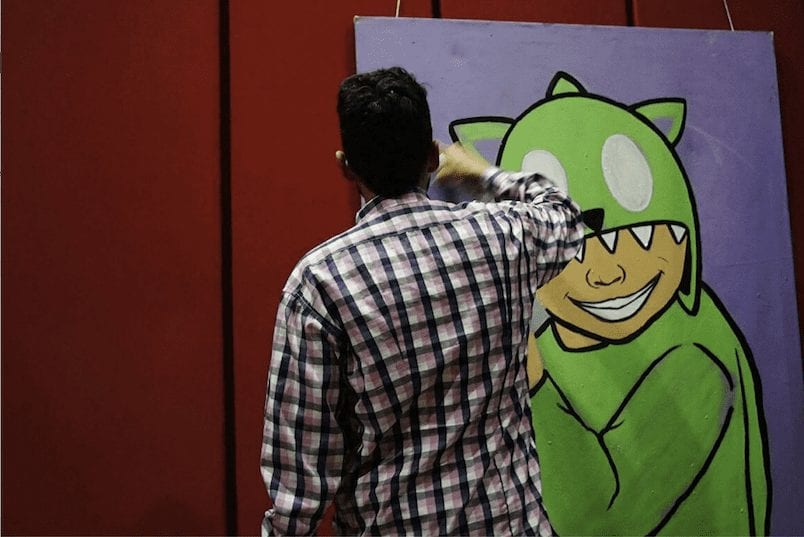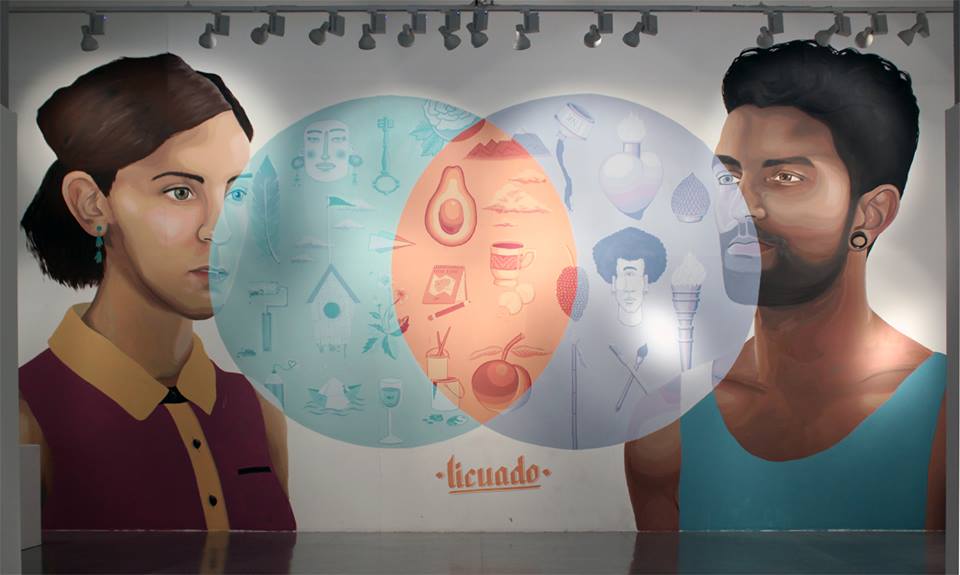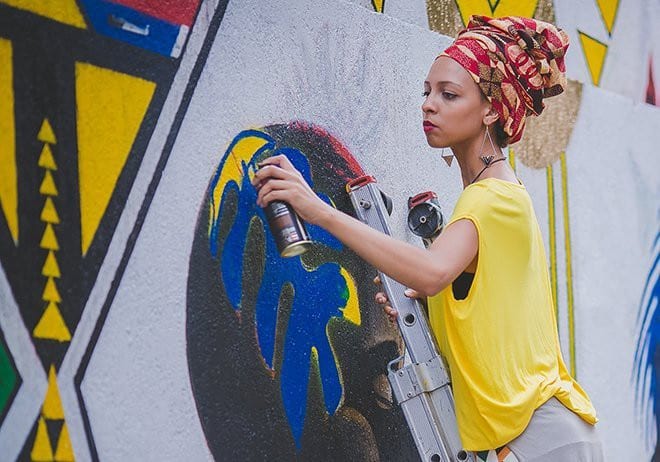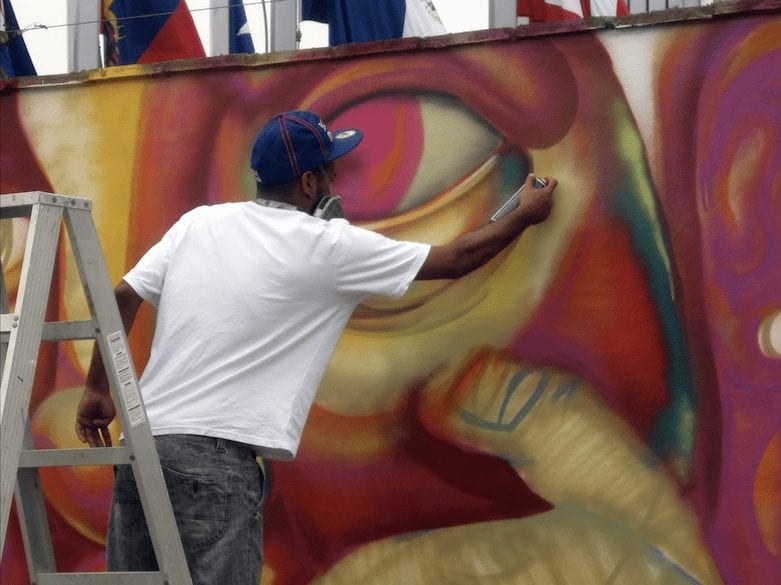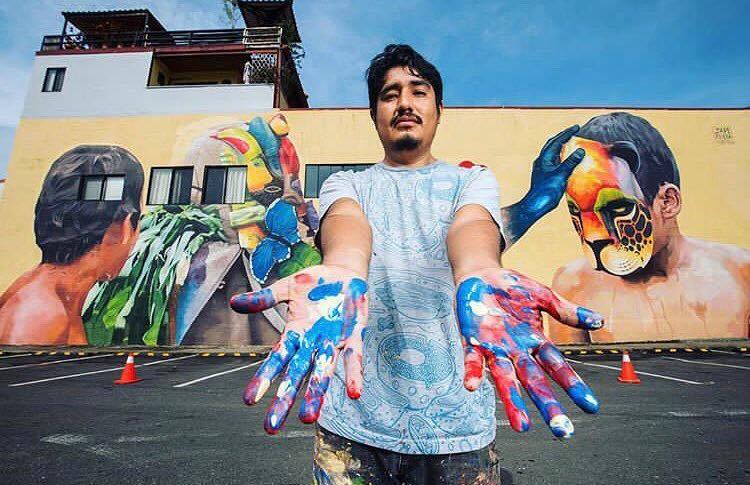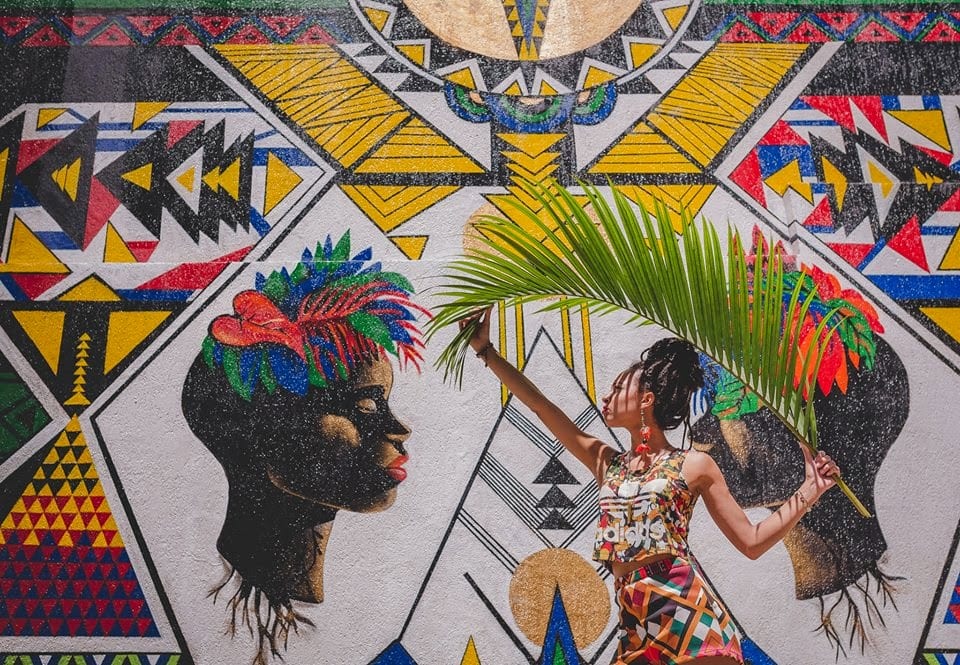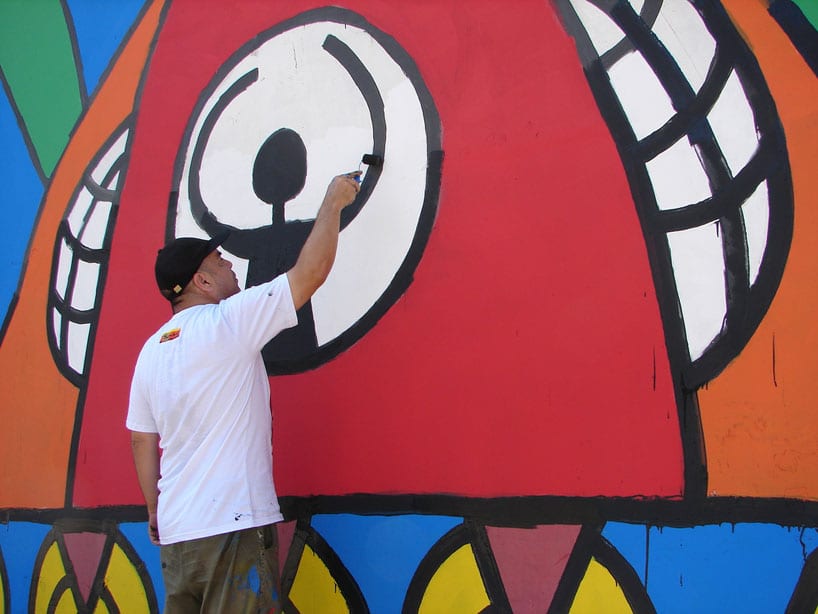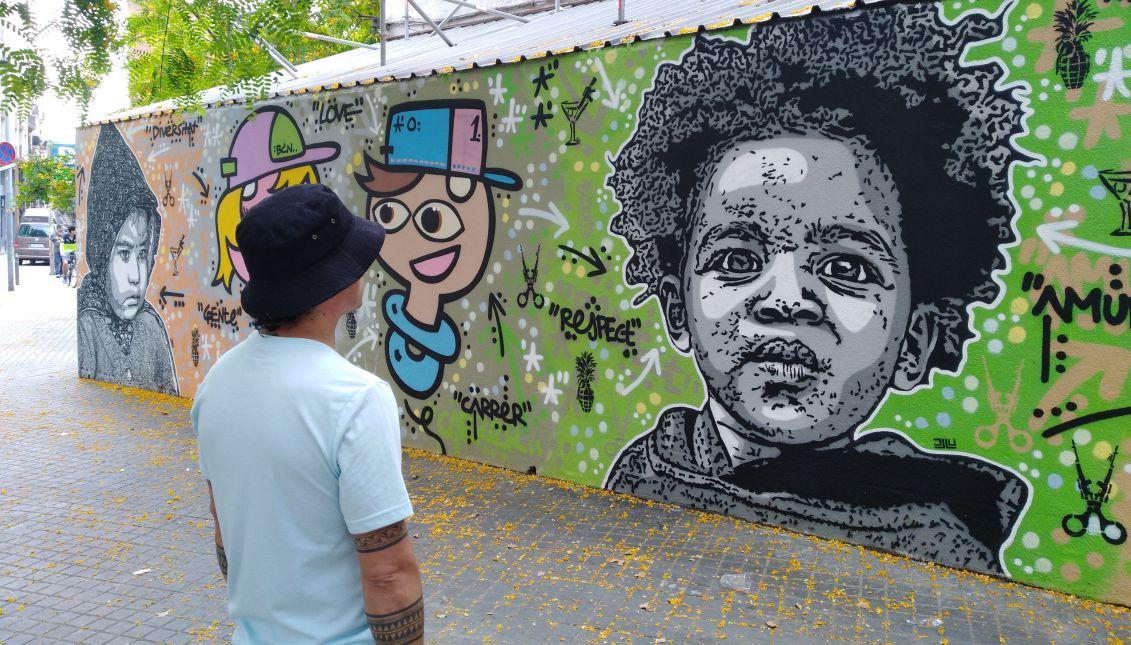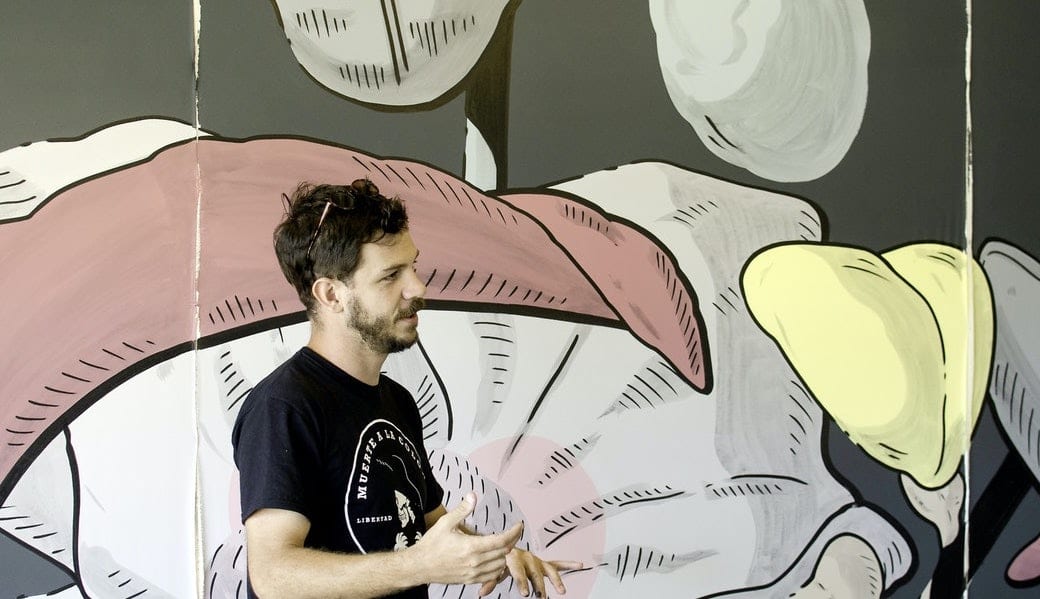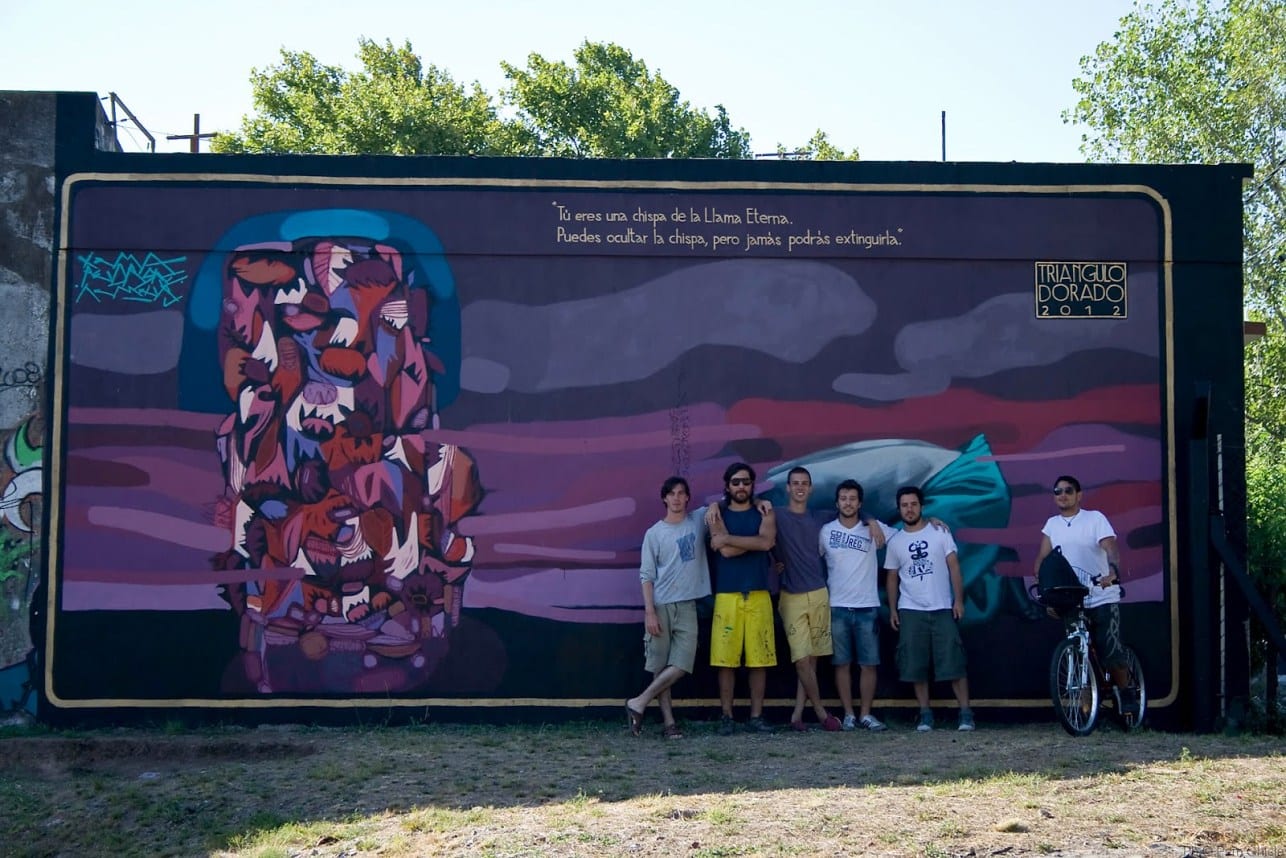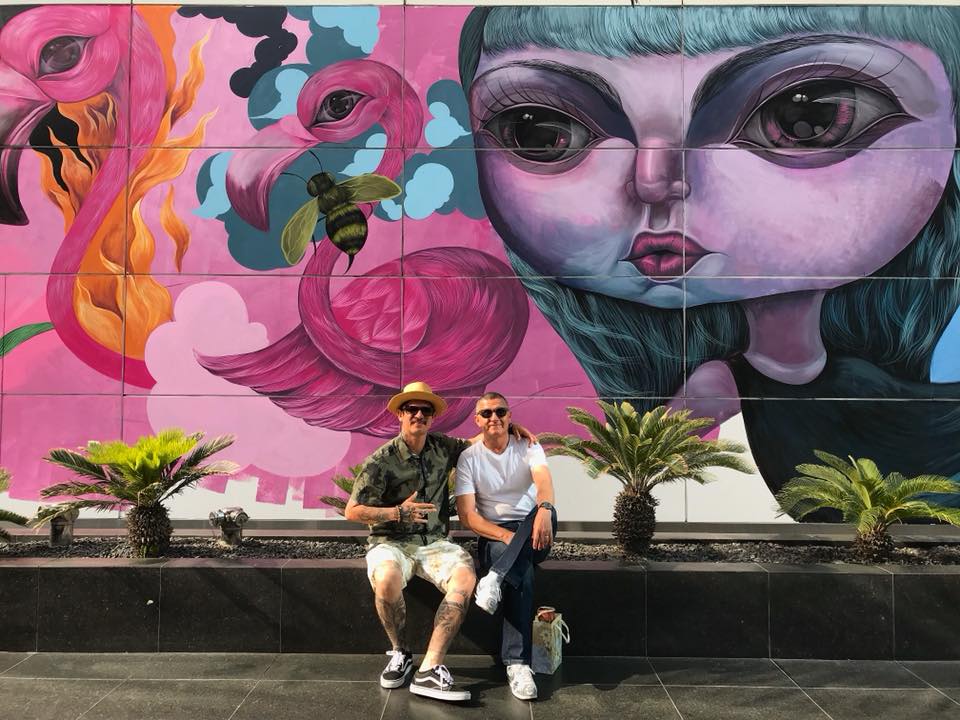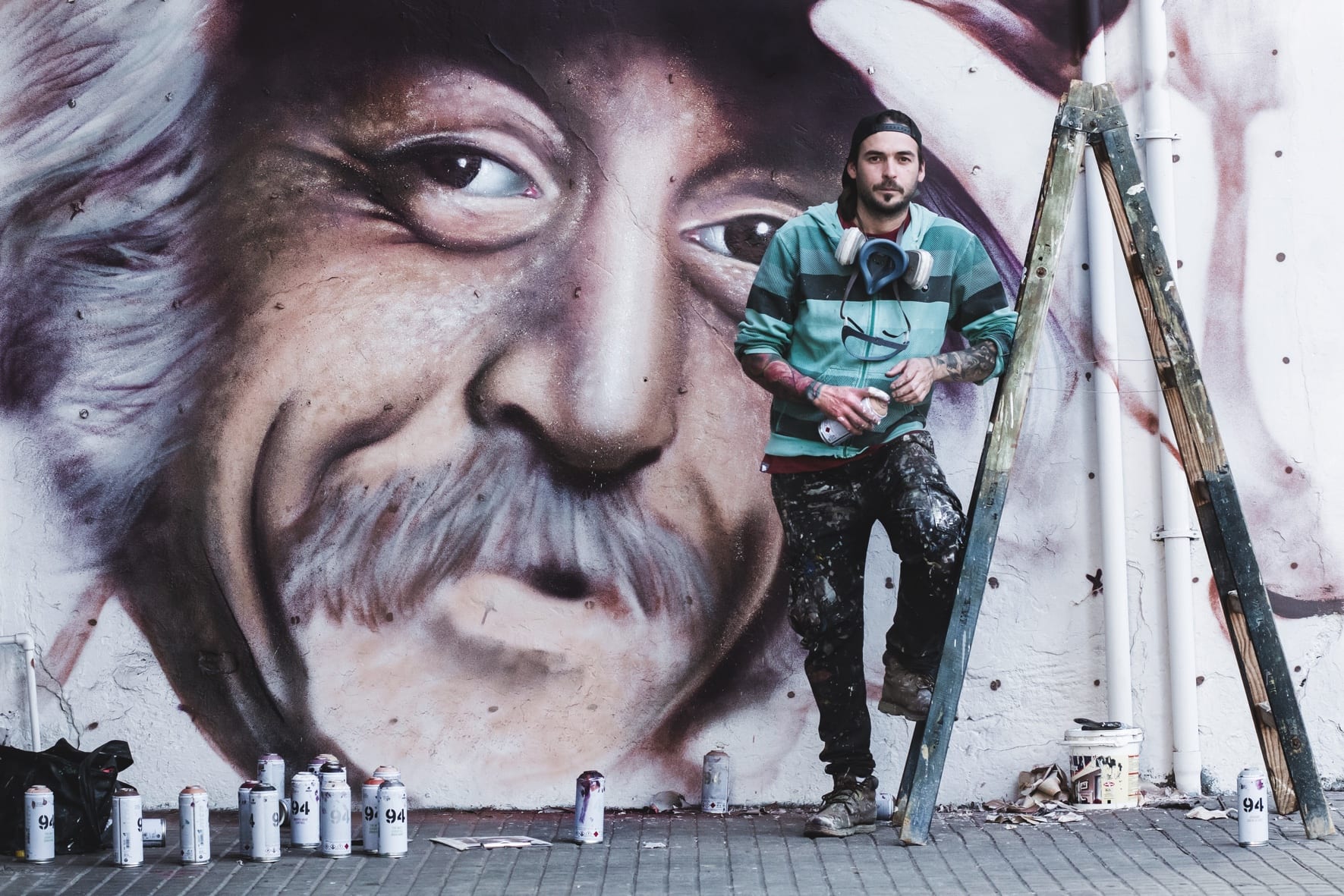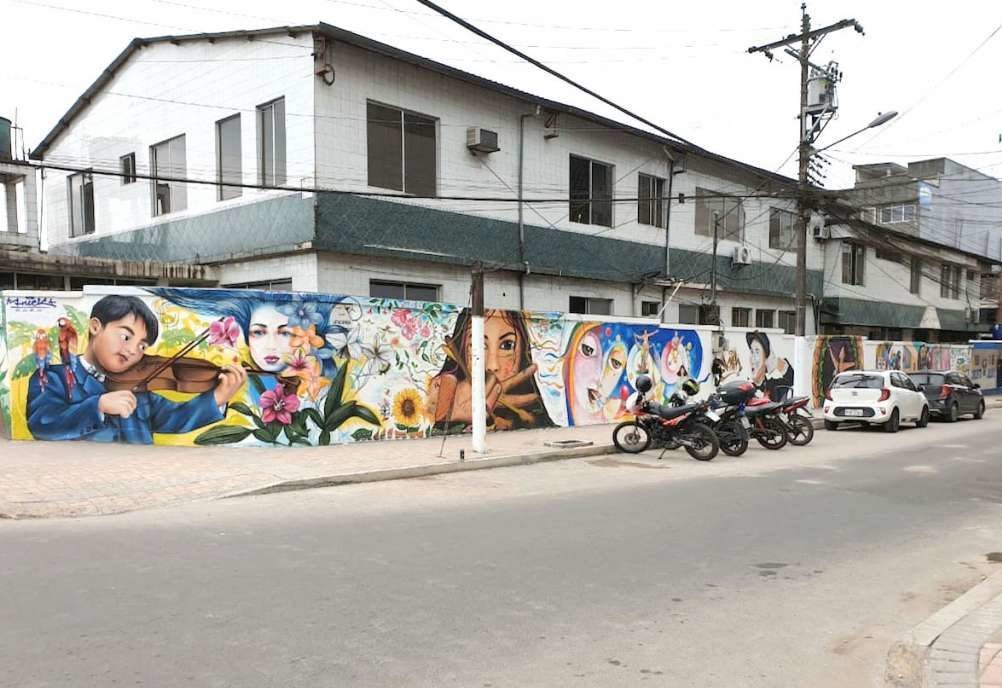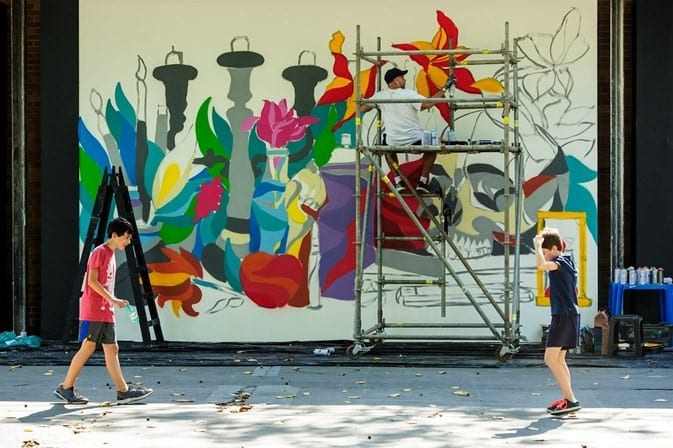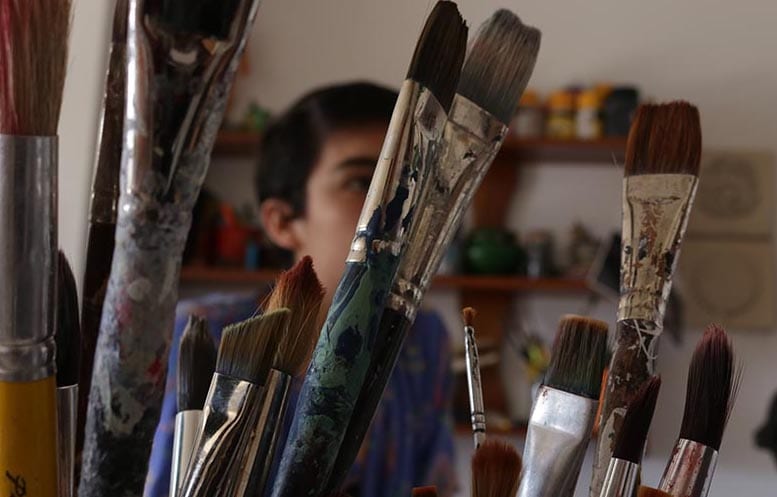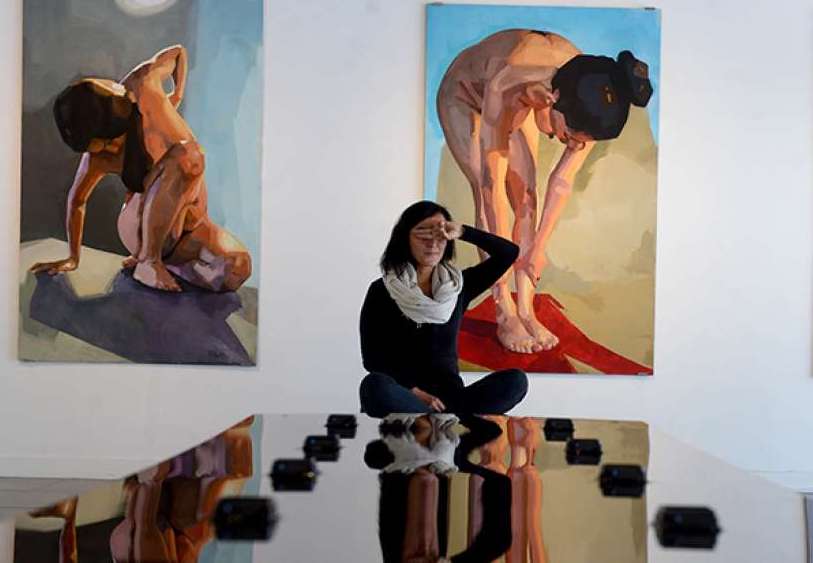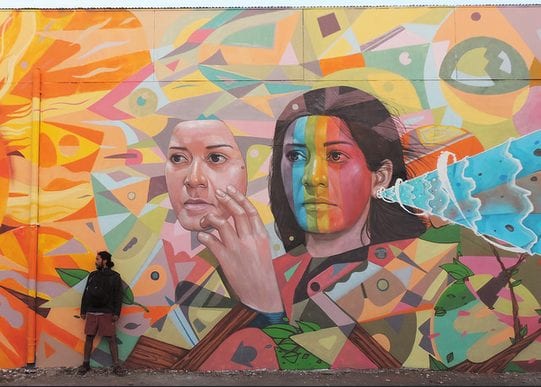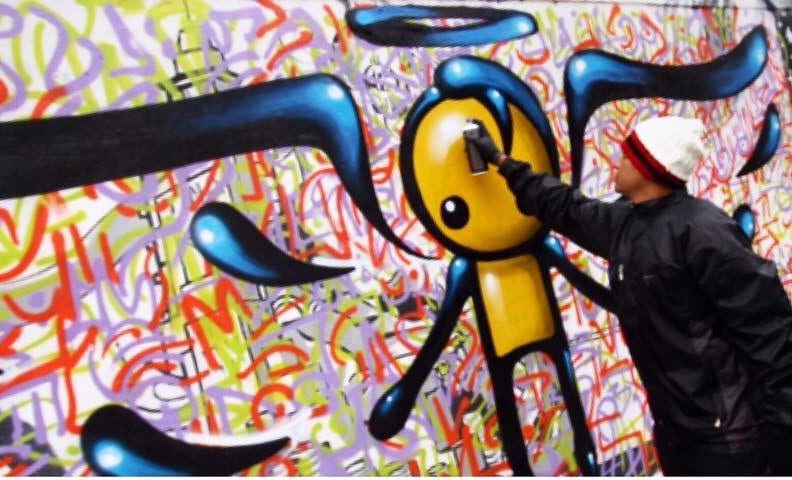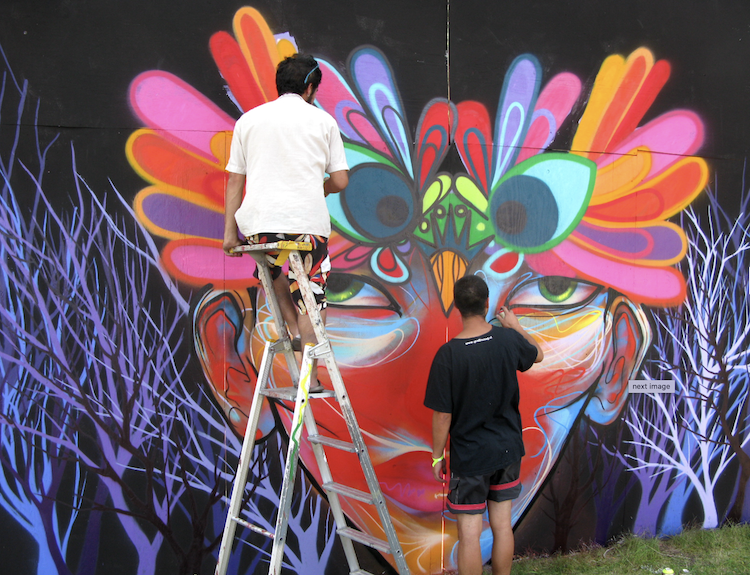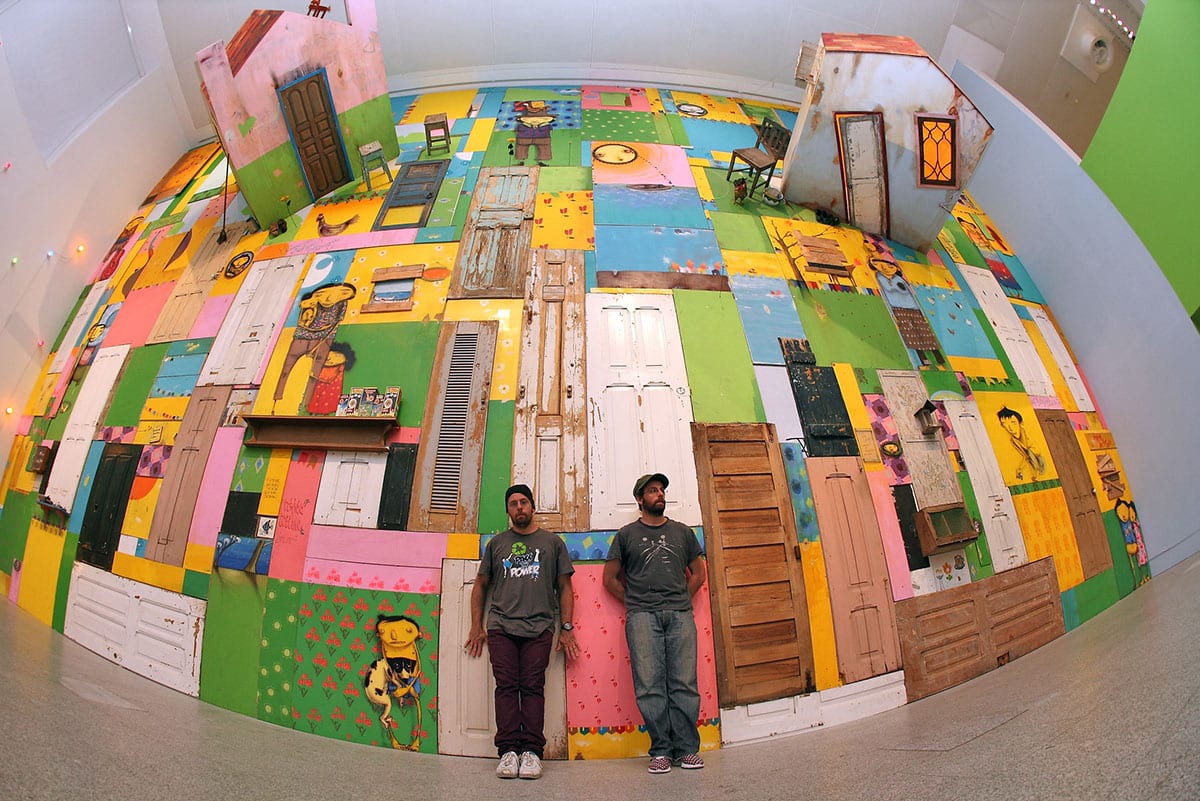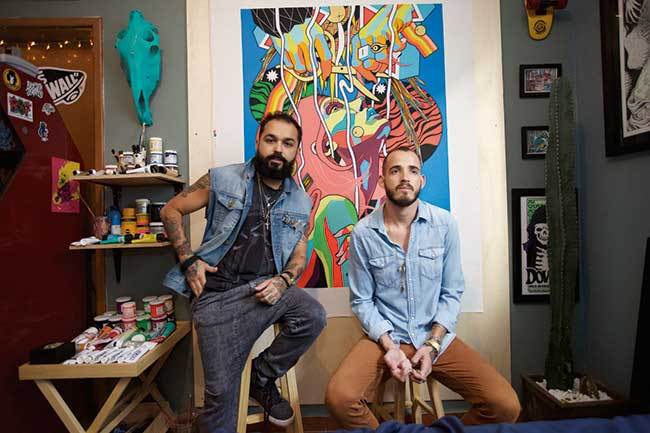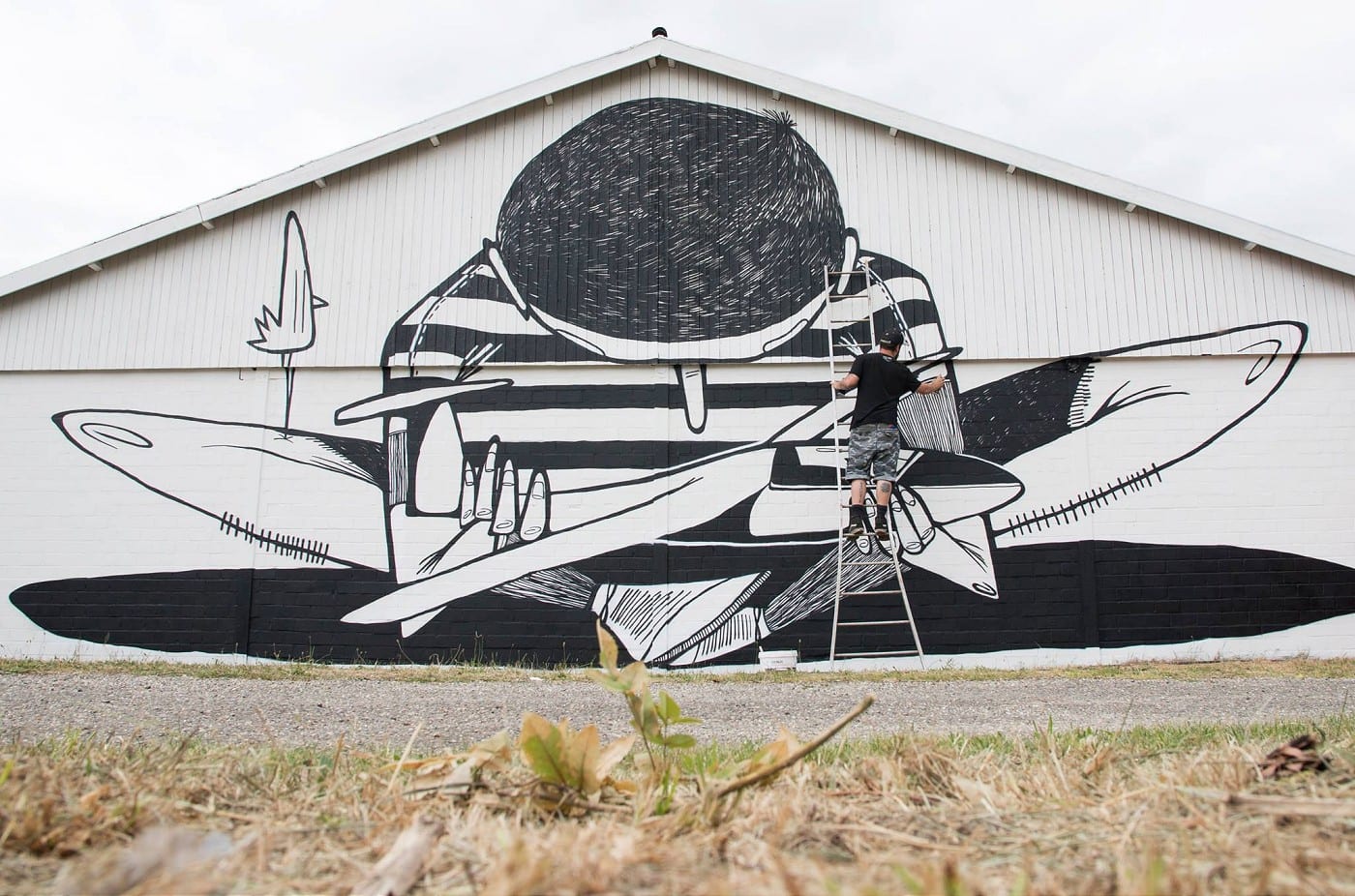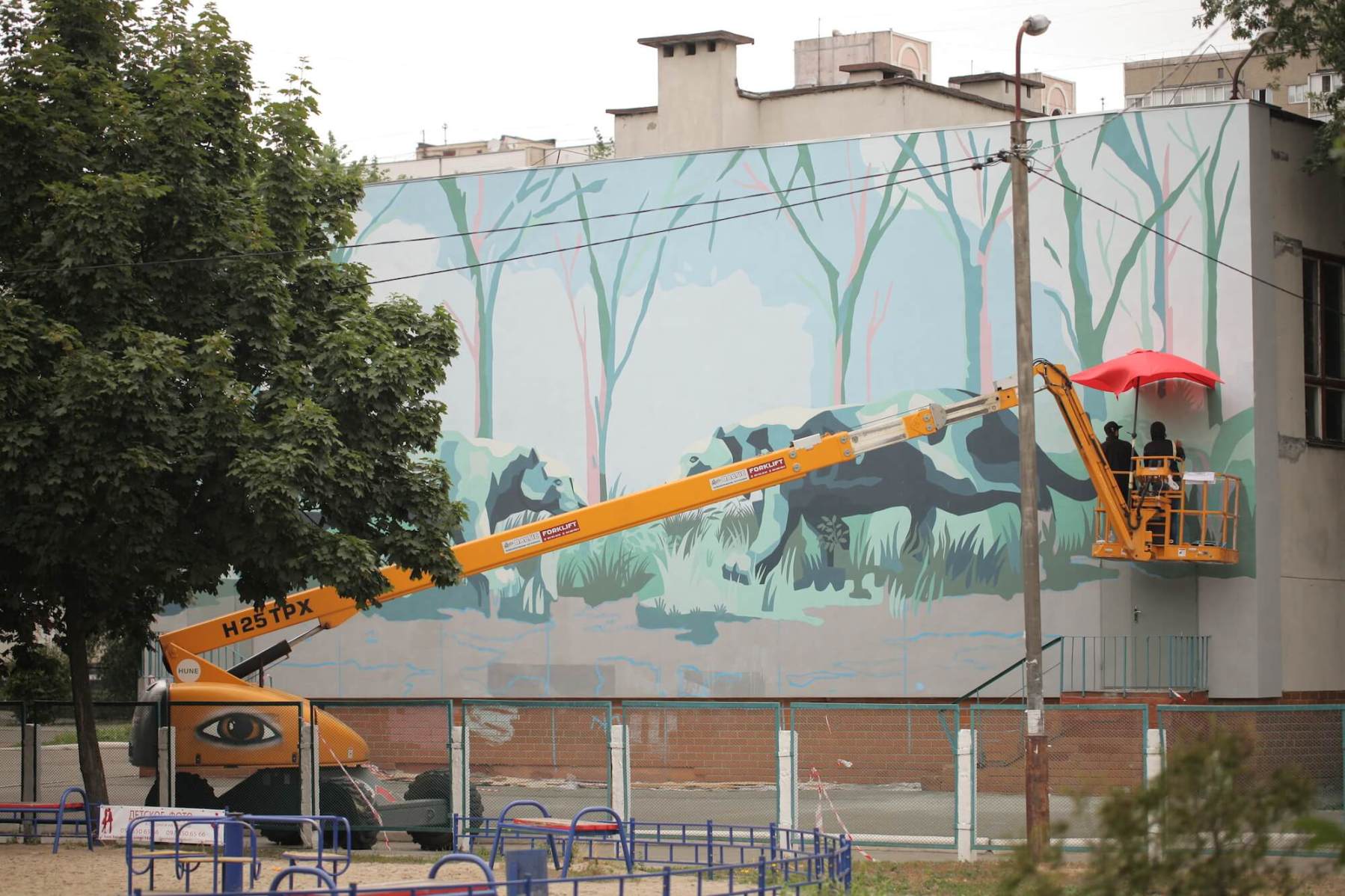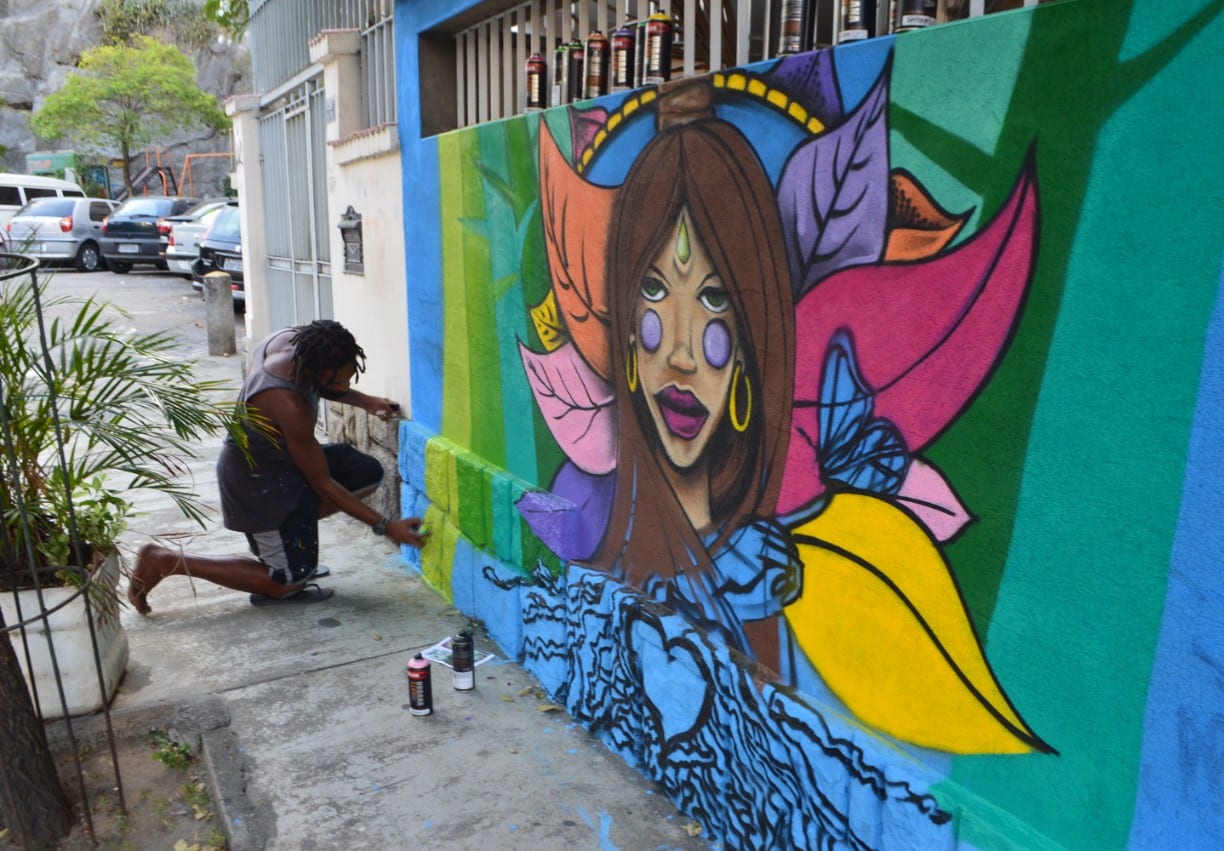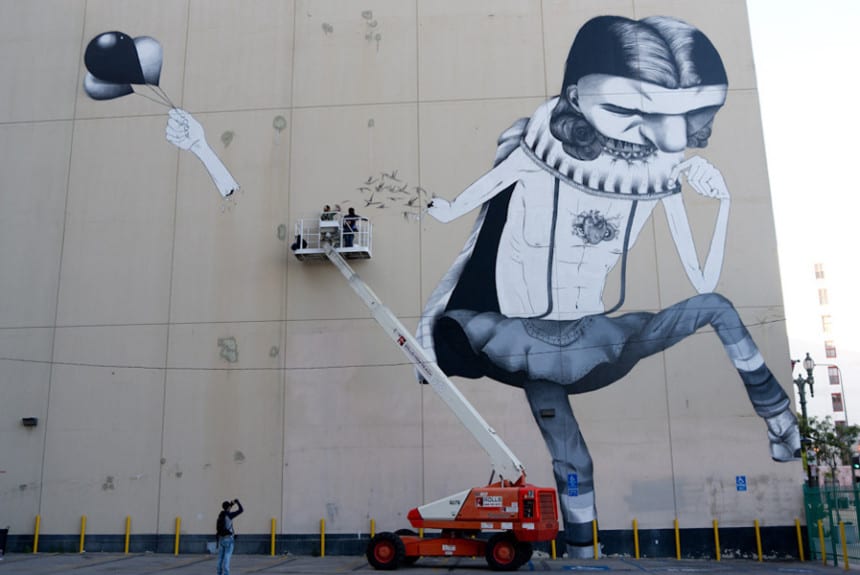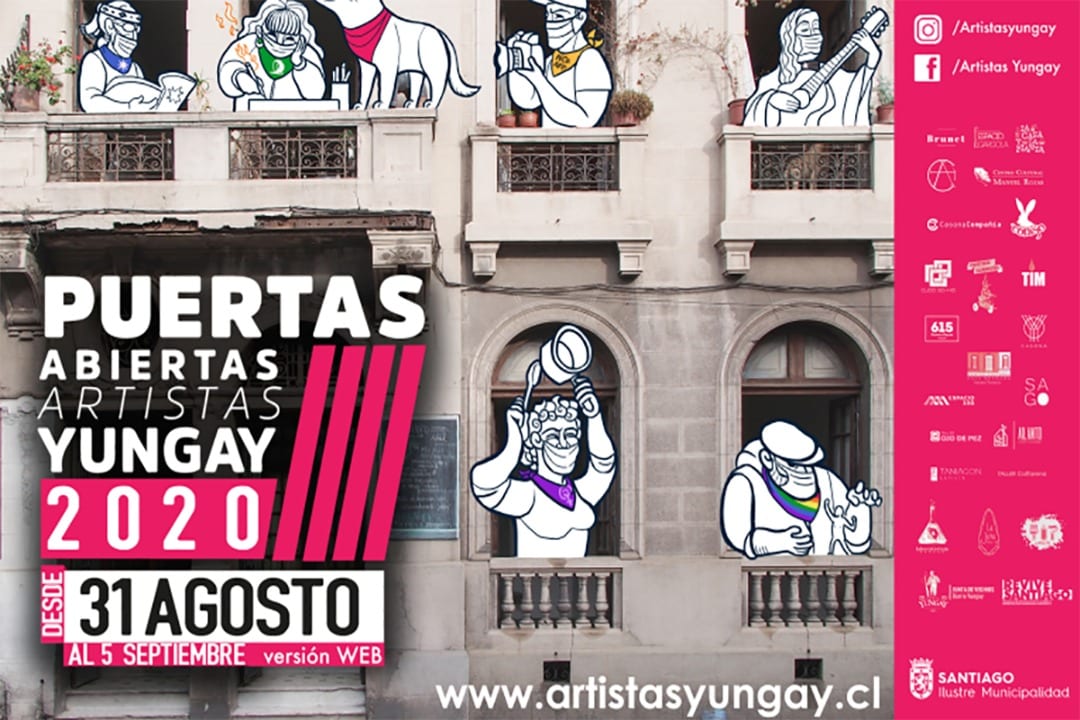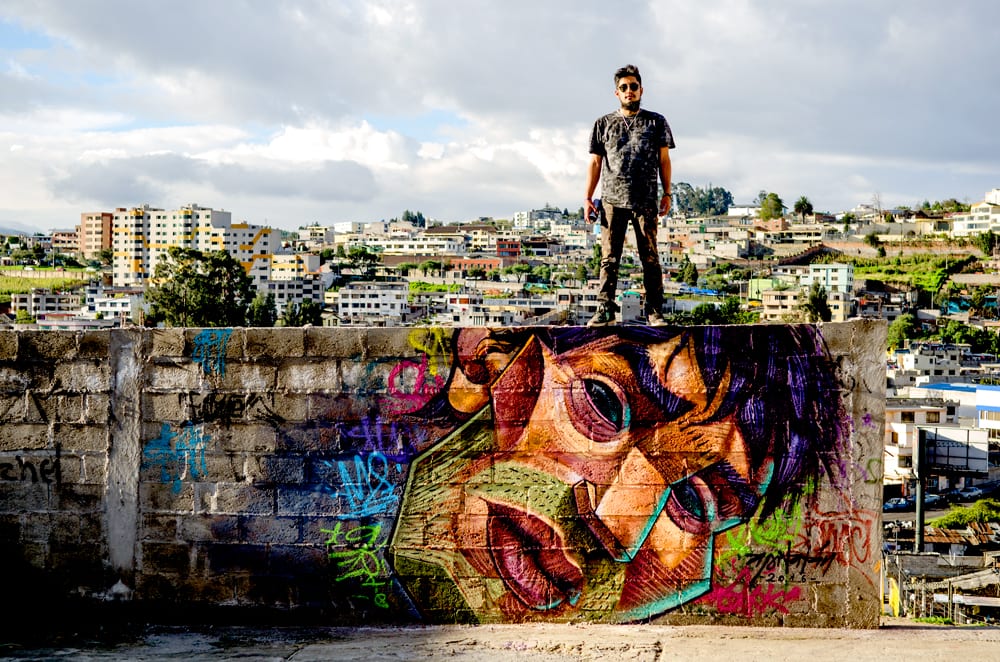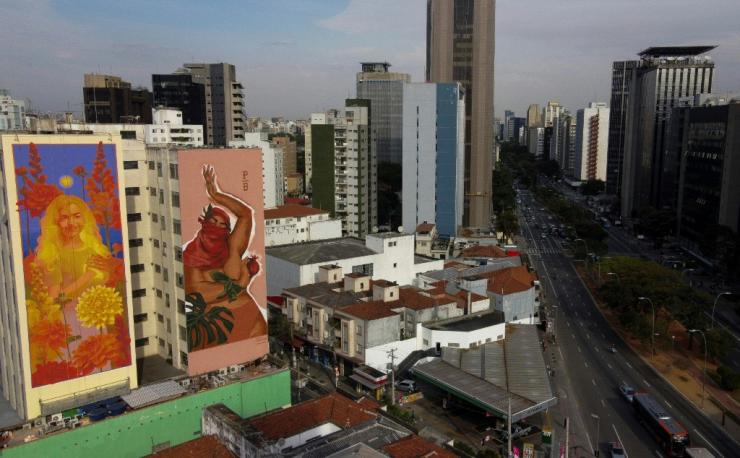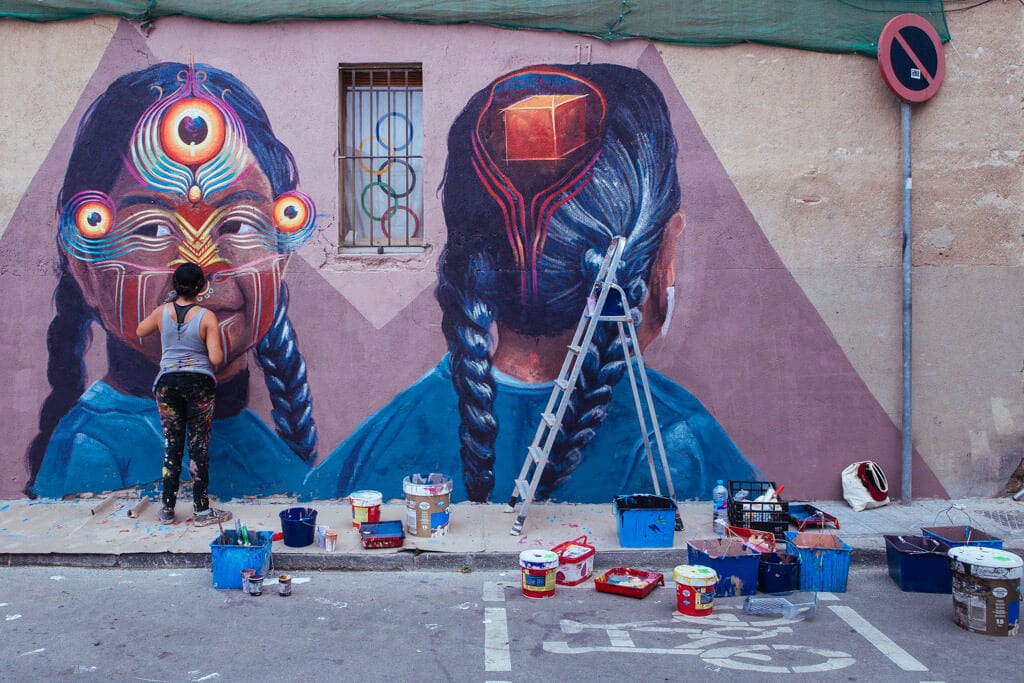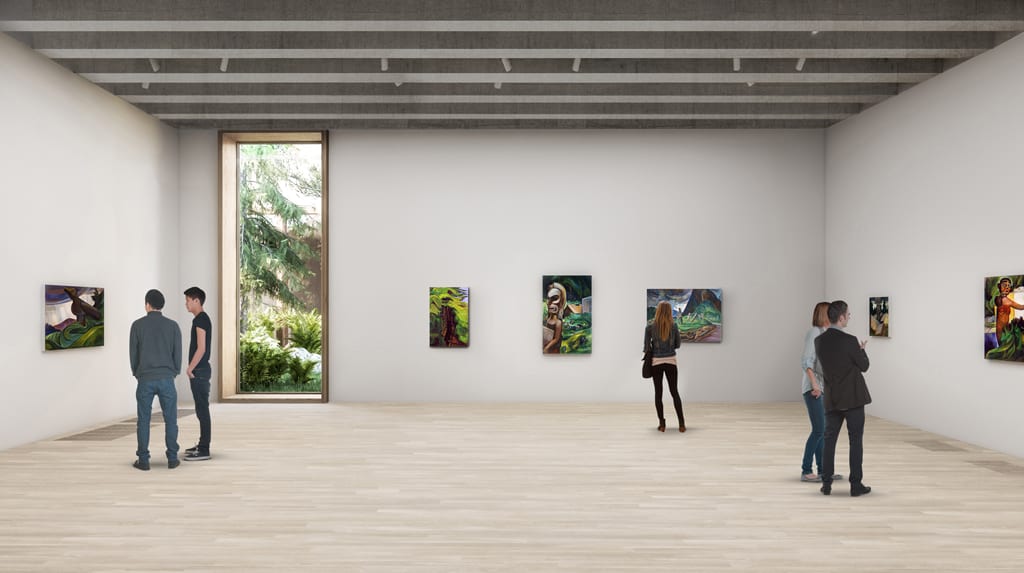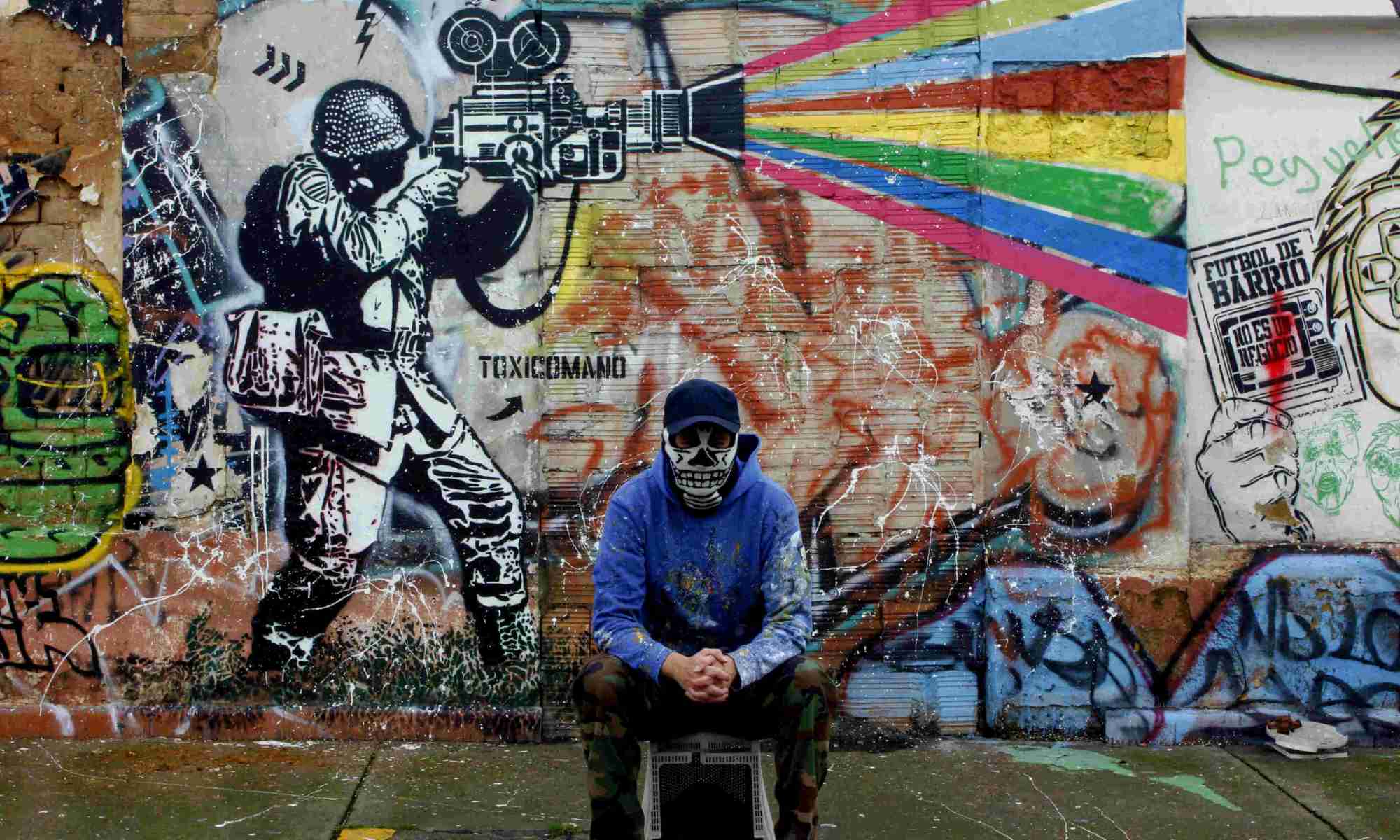Alejandro Molina (Hamk Trazos)
Alejandro Molina, better known by his pseudonym Hamk Trazos, is an urban artist from Caracas, Venezuela who over the years has filled the streets of the capital city. His designs seek to raise awareness of childhood issues through characters that children can relate to, most notably the characters “Los Menores.”
From a very young age he felt an affinity to graffiti and, thanks to his dedication, managed to get his message out on the streets of his city. His artistic name “Hamk Trazos” is a combination of the initials of his names and surnames, adding the word “trazos” (meaning “sketch” in English) which is how he begins every mural that he creates.
Hamk Trazos began painting murals in 2016 and the most common theme in his paintings is children wearing hats that carry a message that teaches society how to care for them. In this way, he hopes to bring back family values that he feels are no longer seen in homes today. He depicts characters that, despite adversity, always maintain a positive outlook on life.
The project was conceived thanks to his younger sister, who he had to care for in the absence of his father; an experience that allowed him to understand many things about the importance of a stable family. In a sense, he learned about the important role adults play in the lives of children today. Inspired by the youngest of the household, these memories continue to drive his work today.
You can follow Hamk Trazos’s work on his Instagram account: https://www.instagram.com/hamktrazos/
Florencia Durán and Camilo Núñez (Colectivo Licuado)
Florencia Durán and Camilo Núñez studied industrial design together at university and later began painting murals together on a grand scale. It started humbly, just with graffiti and stencils on open walls on local street. The results were good though, and they decided to try making a living from it as they traveled. Now, with quite a lot of experience under their belts, they enjoy getting to know new cultures and accurately representing things from them in each new mural.
In Spanish “Licuado” means shake or smoothie and the artists say they chose this name to highlight their blend of talent. They like that after a work is completed there is no way to distinguish between who painted what, just that the overall project has been completed. Both artists in their own way add to the distinctive and unique result; like ingredients in a smoothie after it has been blended.
In their art, they aim for the non-obvious and atypical, but not to such an extent that people in the area won’t feel a connection to, or won’t identify with the subjects they paint. To achieve this, the collective spends a few days in the neighborhood, they talk to the inhabitants, take pictures and over-all spend time there. This they turn into a sort of study in culture, where the objective is to find the positives and beauty of everyday life, not specifically in the conventional way but through observing gestures and subtleties.
Common elements in their works are various types of cultural symbols and portrayal of ethnic groups, cultural issues involving women, and inspiration from mythology and classical art.
You can follow what Collectivo Licuado is up to on their Instagram accounts: @theic_licuado for Camilo and @fitz_licuado for Florencia, as well as on their official website www.colectivolicuado.com/
Tainá Lima (Criola)
Originally from the city of Belo Horizonte, Criola is part of the new generation of Brazilian urban artists whose pieces are informed by issues surrounding their feminine universe and the search for a connection with their ancestry. Graduating in Fashion Design at UFMG, apart from painting Criola also collaborates with several important brands to deliver her message.
In 2008, at the age of 18, she entered art school and in 2012 started making her own paintings. Her graffiti and street art soon caught the attention of people living in her region (Minas Gerais) and she started making a name for herself. She says that graffiti was the type of art closest to her reality, reaching where conventional art does not dare to go.
Raised on the periphery of society and suffering prejudice for her African heritage, childhood proved to be a difficult time. Later, she would channel this experience into her artwork in which she explores the image of the black woman. Based on her own story, she believes that graffiti is a powerful tool for ending prejudice, especially for people coming from a marginalized background.
The inspiration for her drawings comes from women she has met over the years. For her, each woman is a universe of feelings, beautiful and strong at the same time. Other themes she works into her compositions are Brazilian flora, cultural diversity, indigenous communities, prayers, and urban legends; all of these fuel her artistic process. Full of vibrant colors and strong symbolism, her works are not to be missed.
Without a doubt, Criola’s artistic vision is clear and she doesn’t show signs of slowing down. Check out her new ideas, creations, and ventures on her Instagram account: https://www.instagram.com/criola___/
Dasic Fernández
Dasic Fernández is a Chilean born artist but has lived and worked in New York for 11 years. Fernández, whose work is characterized by the use of rivulets of color floating upwards from his subjects, has painted dozens of large murals not only in Chile but also in countries such as Argentina, Uruguay, Brazil, Peru, Canada, and the United States. In September 2016 The New York Times recognized him after being the only Latin American selected to paint a mural at the Hard Rock Stadium in Miami during its renovation.
His influences come from a strong political education, hip-hop culture, and years of architectural studies; and you can sense in his work a kind of light impressionism with political undertones. He has stated that his goal while painting is to be happy and to make people recognize and identify with their own happiness. He says that he hopes his murals bring some positive energy to the neighborhoods where they are painted.
Currently, he says his process involves taking photographs and then sketching in details and adding effects to bring out a sort of hyper-realistism. We saw several of Fernández’s large murals around Santiago de Chile in 2018/19 and we have to say they are really eye-catching. When he’s not planning or painting new murals, Fernández dedicates himself to organizing and teaching his way of understanding and applying art.
You can check out his latest pieces on his Instagram account here: https://www.instagram.com/dasicfernandez/
Jesús Camarena (Xomatok)
Xomatok is the pseudonym of Jesús Camarena, a Peruvian visual artist and art director who spent several years working with a modern aesthetic that transforms urban spaces through the use of color in the most striking way possible, with prisms and bright streams of color gradated over walls and other surfaces.
To date, Xomatok has completed a number of art interventions in public and abandoned spaces, creating both murals and installations, both individually and as collaborations with other artists. His main motivation is to change the appearance of cold and forgotten places in order to give them new life. He is fond of saying his goal is to, “reach beyond the retina,” to wake people up to the possibilities around them.
His murals are inspired by the design and alteration of urban spaces with a clear emphasis on how his color palette completely changes our point of view depending on where we are looking at it from. For him, this manifestation of color and its relationship with everyday human experience is what moves him when it comes to making his work. His murals have a defined aesthetic, drawing the attention of the viewer into the layers of color, making it impossible not to want to get closer to see every detail present in his technique.
Currently, Xomatok is sharing his artistic vision by attempting to transforming each space in which he presents his work. Whether they are large buildings, rocks, the walls of a gallery, stairs leading up through a village, you can find all his new pieces and installations here: https://www.instagram.com/xomatok/
Joan Jiménez (Entes)
The Peruvian artist known as Entes (real name Joan Jiménez) has been a muralist and promoter of urban art for over 22 years now, painting murals in more than 20 countries around the Americas, Europe, and in Africa. Now he is seen as one of the main urban art figures from his country at the international level.
When he first started out, his parents were opposed to the idea of him dedicating his life to drawing and said they would only allow it if it was related to a professional career like architecture. So, with the road to artistic expression closed at home, Entes was forced to take to the streets in search of spaces to draw and paint. Looking back, he says that this only motivated him more, and it taught him to be disciplined, respectful, and to keep the faith alive that he can achieve his dreams.
Interested in Afro-Peruvian culture, he bases his work on the investigation into marginalized groups in society, clandestine culture, and racial an class-based discrimination. His characters often have deep set gazes that tell stories of life on the streets, narrating impressions he collects and the day to day lives he witnesses in the city of Lima.
For many years, Entes has worked in association with Pésimo, another of the heavyweights of urban art in Peru (if you check out our article on Pésimo you will see a collaboration piece they did together). The pair, in addition to traveling the world making art, has promoted a number of new talents on the Peruvian urban art scene. In 2012, they created the most important graffiti festival in Perú, “Latidoamericano,” that quickly became popular on an international scale.
You can follow Entes on his Instagram at: https://www.instagram.com/entes93/
Jade Rivera
Jade Rivera was born in Junín, Peru in 1983 and is widely recognized for his large-format murals that often feature people and disproportionately large birds and insects depicted with a heavy dose of surreal mysticism. Apart from painting murals, Jade spends much of his time working in the studio exploring more traditional techniques such as oil and watercolor painting and wood carving. If you ever find yourself in Lima it’s worth visiting his studio which now operates as a gallery and museum. https://museojaderivera.com
Rivera grew up in the Chorrillos district of Lima, studied at a public school, and it was there that he first took an interest in art when he was eleven years old. The lack of skilled teachers at his school and his growing interest in art motivated him to devote more of his free time to drawing and painting by himself. Some time around 1997 he started working as a self-taught artist producing gallery pieces.
As he struggled to find his way as an artist, Rivera spent much time searching for for people who shared his passion for painting, for more accomplished artists he could emulate, and for friends he could exchange ideas with who were following a similar path. His search led him to discover the works of the Mexican muralists Diego Rivera, José Clemente Orozco, and David Alfaro Siqueiros. It is these artists who inspired him to carry his message to the streets and to find expression through painting murals.
Jade Rivera pays close attention to what the street tells him before starting work on a mural. He has stated that the whole environment tells him what to paint, including the houses on the sides, the people who live there, the landscape. He then makes the decision to paint when he feels he has a fairly broad vision and is able to integrate all that he has observed from the location.
His murals are usually reflections on life and its constant eventfulness, portrayed with a definite sense of optimism and wonder. Jade says he is interested in expressing a message of faith originating from oneself, as well as the importance of believing in our own dreams.
Jade Rivera regularly posts updates of his work on his Instagram account, which you can check out here: https://www.instagram.com/jade1rivera/
Nina Pandolfo
Nina was born in 1977 in the city of Tupã and a bit later her family moved to the capital of São Paulo when she was still just a baby. As a teenager, she always showed interest in painting and drawing, and, along with a group of friends she met while studying visual communication, Nina experienced the excitement of street painting for the first time along Avenida Tiradentes, in the central of São Paulo.
Distinct from the street art movement defined by protest and antiestablishment messaging, Nina is part of a group that decided to take graffiti to art galleries and museums. Apart from her large public murals, she also creates paintings on canvases, art installations, and objects made with different materials such as latex, resin, plastic, and fabric.
Her first street art pieces were simple letterings—for example, her name in stylized characters—and little by little she moved towards painting the subjects she is most known for today, a series of girls seemingly influenced by characters in comics and anime. She had already been experimenting with these subjects on canvas using simple lines and over time the works became more and more complex and detailed both on canvas and on the walls of the city.
The main themes of her work are images of childhood and of nature. Nina explores the relationship between the innocent gaze of children—portrayed by girls with big wide spaced eyes— and secret feelings mirrored by the soul. The artist also incorporates the beauty in all animals in her art, highlighting insects, fish, and cats in her murals and paintings.
Her objective is to show that we can see life in many ways, and that we can see life through a simpler lens, with more hope and sincerity, and that the same images can have totally different meanings to different people.
You can check out Nina’s newest creations on her Instagram account https://www.instagram.com/ninapandolfo/
Brazilian Muralist Criola to Represent Urban Artists in the Upcoming UFMG Winter Festival
Between September 14th and 23rd, the UFMG (Federal University of Minas Gerais) will conduct its 52nd Winter Festival. One of the most important and traditional cultural events in Brazil that, this year in 2020, plans to reinvent itself to be held online, with activities open to the public. The Festival will have lectures, conversation circles, and artistic presentations broadcasted live on YouTube, in addition to virtual exhibitions and the launch of digital publications by Brazilian thinkers.
Under the theme “Possible worlds: Cultures in Thought,” the Festival proposes a discussion on the role and meaning of culture in a context of crisis and social confinement. Thus, UFMG invites thinkers, philosophers, activists, and indigenous leaders to the debate, for the Seminar “Culturas em Pensamento.”
The festival’s menu of cultural attractions offers music, dance, and performances to the public. The event will follow five online exhibitions associated with the Winter Festival program, in addition to an exhibition that will project images and videos on buildings in the city, which will lead to an opening exhibition by urban artist Criola.
Criola is a representative of Brazilian urban art with works in Europe and South America. While immersed in social and political agendas, her large-format murals touch on ancestry and question the values of contemporary society, addressing spirituality and a futuristic hybrid universe without illusory distinctions between human beings and nature.
The entire program will be available at http://www.ufmg.br/festivaldeinverno .
Rui Amaral
Considered one of the most influential graffiti artists in Brazil, the multimedia artist Rui Amaral is part of the pantheon of the first generation of modern urban art in São Paulo, which emerged in the late 1970s. A multi-faceted and versatile creator, he explored various platforms such as animation, toy design, and video production. His works usually refer to the universe of children’s imagination and urban modernity. Around 2008, he created his own mascot “Bicudo,” a smiling figure that, according to the author, “represents the joy that the cities tend to lack.”
Rui took part in the development of the famous “Batman’s Alley” (Beco de Batman), named in the 1980s after a group of art students painted a cartoon of the comic book hero on the wall. While Batman’s Alley served as his initial space for creation and experimentation, after that, his main works can be appreciated in the tunnel on Paulista Avenue.
Rui has a Plastic Arts degree, but he also has carried out projects of graphic design, animation, and production of multimedia. He also works on the creation of websites and advertising, while being responsible for regular graffiti and urban intervention workshops.
You can follow Rui Amaral on his Instagram account to see what he’s up to https://www.instagram.com/ruiamaral_
Nicolás Germani and Sasha Reisin (Primo Murales)
Primo Murales is the name of the street art duo formed by Nicolás Germani, an industrial designer and visual artist, and Sasha Reisin, a graduate in electronic arts. In 2012 they began creating urban interventions on walls and making a name for themselves in the street art scene of Buenos Aires and the interior of Argentina.
As the name suggests, they are actual cousins (“primo” means cousin in English) that grew up together, and with strong support and encouragement from their families, followed their artistic leanings that would eventually lead them to painting large murals in the neighborhood. They started simply, by painting the patio of one of their houses, from there it expanded to other neighboring patios and terraces until finally it reached all the way out to one of the walls facing the street, which is now their preferred location to paint.
The group considers itself part of a generation of muralists from the visual arts who place an emphasis on figurative representation. Taking advantage of portraiture and nature, their work is based on the contrast between local and globalized culture, alongside individualized expressions of native communities; many times pointing out some juxtaposition. They have stated that the resignification of the way we build our routines and daily lives is one of the main themes present in their works.
You can follow Primo Murales via their Facebook account https://www.facebook.com/Primo.Murales/
(Juegasiempre) (DJ LU)
Juegasiempre, also known as DJ LU, is a Bogota architect and urban artist who paints large murals and also works as a university professor. He’s considered one of the most important proponents for urban art in Colombia, and along with Lesivo and Toxicómano is part of the Bogotá Street Art Collective.
Although well-known among his peers, he prefers to do what he can to keep his identity out of the media and goes mainly by the name Juegasiempre (always playing)—reflecting his approach to life and to his art. In interviews, he wears a distinctive gas mask to hide his identity and many people mistakenly think this is to protect himself for legal or security reasons, however, he states that it is to avoid diverting the viewer’s attention from his artwork. Also, he says he does this to take advantage of the common stereotype that the stranger, weirder or more disturbed the artist is, the better an artist’s work will be.
His earliest pieces used a very distinctive style of pictogram art which later evolved into large portraits of people from the streets of the places where he is painting. Very eye-catching, he uses this approach in order to draw attention to pressing social issues of the day. Through the use of creative irony, denunciation of oppression, as well as the idea of people bearing “wittiness” to social and political problems such as violence and racism, for more than seventeen years now his murals and pictograms have continued to attract people’s attention on the streets of the world.
Juegasiempre shares his thoughts, images of new pieces, and topics he finds interesting via his Instagram account https://www.instagram.com/juegasiempre
Oscar González (Guache)
Oscar González, better known as Guache, is an urban artist from the city of Bogotá, Colombia. Guache’s art is heavily influenced by Latin American political muralism of the first half of the 20th century and by art from indigenous communities. Through his work, Guache hopes to explore ideas of social interest such as identity and ancestral culture.
He chose “guache” as an artist’s name because it’s a word that has many meanings. In his country, it is currently derogatory and often used to describe rude people; originally however, it was used to describe a “Muisca,” or, indigenous warriors. As this dual-meaning suggests, part of his mission is to liberate language and take back cultural symbols in Colombia and in the rest of Latin America.
His natural drawing skills and a hunger for comics and graphic novels led him to create his own comic series at an early age. Later when he started studying graphic design, he found people with the same desire to experiment and edit fanzines and various publications. It is then that he became familiar with screen-printing, which was followed by his other two passions: stencil and graffiti. At some point during his career, he began to incorporate indigenous themes into his work, giving it a new look. Nature, animals, and mythic symbolism is a fundamental part of his art and many of his pieces include representations of sacred totems.
His style and choice of subject continues to evolve as he explores new cultural phenomena and integrates what he sees during his travels. A common tendency is to focus on one element that attracts his attention, develop it, and occasionally combine it with others elements to see what novel effects he can produce.
Guache has an Instagram account where you can follow his latest updates: https://www.instagram.com/guache_art
Francisco Díaz (Pastel)
Francisco Díaz (better known as Pastel), is an Argentinian urban artist and architect who started painting on the street in 2001. Today, his work focuses on a critique of modern living; adding value to architectural structures by decorating them with sprawling flower gardens in the form of murals.
While on the surface his pieces seem simplistic and more decorative than artistic—typically arrangements of plants and other elements on a grand scale—a deeper look reveals that withIn his compositions, flora and fauna interact as conceptual tools that often symbolize events that took place in a certain area, resulting in works that encourage a dialogue between humanity and space, as well as the contrast between the industrial world and the natural world. Two recurring elements within his pieces are are arrow-shaped stones and flowers native to the place where he is painting. He developed this concept over many years based on personal interpretations and experiences. Using various materials such as watercolor, tempera, and even technical drawing (due to his architect background), he is able to create works in which the organic and the figurative coexist in perfect harmony.
You can follow Francisco by checking out his Instagram account: https://www.instagram.com/pastelfd
Elian Chali
Elian Chali is an Argentinian street artist and muralist, born and raised in the city of Córdoba. He began painting at the age of 16 and by the age of 20, was completely dedicated to the arts. Although he possesses a degree in graphic design, his training has been mostly self-taught and he attributes his skill as an urban artist mainly to things learned from other people and participation in countercultural circuits that he always gravitates towards when he arrives in a new place. According to Chali, traveling to different places and having a wide range of life experiences is the most valuable thing for living a rewarding life. Now, with pieces spread across 32 different countries, Chali says it’s difficult to say with certainty the exact number of pieces he’s created to date.
While his influences and techniques vary, Chali pieces tends to incorporate large geometrical shapes, abstraction, and occasionally sociopolitical messages. The purpose of his pieces he says, is to put on the table the social issues that occur around him, as well as highlight the beauty of the places where his art installations are placed. In recent years he has turned his technique a bit towards perspectivism to draw attention to the dynamism of the cities he paints. With this approach and using a plethora of bright solid colors, he strives to show the changes and evolutions of cityscapes. After finishing the first stage of a work he then adds elements such as layers, overlays, and geometry that contrast with the gray tone of the surrounding walls. His canvases of choice for these pieces are buildings, cultural centers, museums, town halls, and even the floors of soccer fields.
Elian Chali has regular updates of his work on his Instagram account, which you can follow by clicking this link: https://www.instagram.com/elianchali/
Santiago Panichelli, Pedro Panichelli, and Francisco Ferreyra (Triángulo Dorado)
Formed in 2007, Triángulo Dorado (“Golden Triangle” in English) was one of the most influential artist collectives to join the Buenos Aires street art movement. The group was made up of three artists: Santiago Panichelli (Nemer), Pedro Panichelli (Hombre Tiki) and Francisco Ferreyra (Lema)–all three Fine Arts teachers. In June of 2013, Ferreyra split from the group to form his own collective LEMA while Santiago and Pedro changed their crew name to Presente.
As it turns out, all three artists grew up in households where at least one parent was a painter; subsequently, all three began drawing and painting from an early age. They first met in 2001 while attending the same high school. It was Santiago who first nudged the group into painting in the streets, and, the more they painted, the more they realized the far reach that this type of art has on people. Independent of intermediaries and of current trends, they were able to produce pieces that a vast public was able to appreciate.
Murals by Triángulo Dorado have a very refined and recognizable look. Influenced by expressionist painters, they explored techniques and styles from a wide variety of contemporary and classic movements dedicated to urban art interventions. They also experimented with abstract geometric compositions and with astonishing figures with surreal bodies but surprisingly realistic faces displaying a high degree of detail. Works by Triángulo Dorado are recognizable for their use a royal color palette on dark-toned backgrounds, and for their use of eye-catching figurative elements such as calligraphy and geometric shapes.
Before their eventual split, in many respects Triángulo Dorado was representative of a new generation of street artists and muralists. Despite moving in different directions, all three members continue to produce art pieces true to the style they developed together. To see their latest projects, have a look at Presente’s Facebook page: https://www.facebook.com/PresenteCrew/ and for LEMA: https://www.facebook.com/FHFerreyra/
Conrad Florez
Ricardo Conrad Flórez was born in Lima, Perú and later his family moved to the city of Ventanilla where he would eventually get involved in the street art movement. Growing up his attention naturally drifted to urban art, comics, and graffiti because that’s where he felt free, unchained, and full of adrenaline. Another big influence on him was Todd McFarlane, the creator of the superhero “Spawn” and bands like Korn, Slipknot, and the Deftones.
Conrad was born to be a painter and states that he never lost his way or had a vocational crisis. He always knew that he was going to be an artist. His parents never objected to his choice of career and the young artist soon realized he could make a living from art. As he grew older, he experimented with several styles and a number of genre, but always came back to his centers; making urban art, seeking freedom, and promoting rebellion.
As soon as he finished high school, he entered a Fine Arts academy. Unfortunately, his expectations of action, active creation, and lots of painting were met with the reality of having to endure endless classes on theory. So, he decided to drop out of school and leave the Fine Arts forever because he felt that he was taking a spot from someone who really wanted to be there.
Despite dropping out he was still able to make a lot of great friends; people like Pésimo and Chimpa, both important figures in the street art scene and both close friends who helped him coming up. He formed a team of artists and forged the artistic collective DMJC (Dedos Manchados en la Jungla de Cemento, translated as “Stained Fingers of the Concrete Jungle”), which soon achieved a degree of notoriety with their many graffiti and murals on the walls of their city.
Today Florez does not limit himself just to painting only street art but also paints pieces for galleries, does interior design work, and has painted large commercial projects for shopping centers. His art has gained a massive number of followers and appreciation, turning him into a central street art figure in his country.
You can follow Conrad Florez on his Instagram account to find out what he’s up to: https://www.instagram.com/conradflorez
Cris Herrera (Kiki)
Colombian Street artist Cris Herrera, better known as “Kiki,” has been living in Argentina since 2015 actively producing a number of large intricate murals. Focussing heavily on the communities where he is painting and always conscious of the local values and sensibilities, he tries to leave behind pieces that will be meaningful to the people living there. To help him achieve this level of versatility, he is always experimenting with new styles and techniques gleaned from fellow street artists.
He got his start drawing simple images on sidewalks with chalk. The ephemeral nature of these pieces opened his eyes to the magic of street art and today, even though he is creating much more grand compositions, he still says he doesn’t mind if his works end up destroyed by nature or vandalism, as long as long as he manages to communicate something through his art. His favorite technique these days is to mix spray paint and acrylic paint, always experimenting to achieve better results.
Kiki is among a number of other South American street artists (as well as some American and European artists) who have chosen to, through their work, pay tribute to the great ancient civilizations of the region such as the Maya, Inca, and Aztecs.
You can check out Kiki’s most recent murals on his Instagram: https://www.instagram.com/crisherrerakiki/
Edwin Higuchi Fernández (Pésimo)
Pésimo or Edwin Higuchi Fernández is one of the most renowned graffiti artists in South America with over 20 years of experience and hundreds of murals to his name. A central figure in the Peruvian urban art world, Pésimo has now painted in more than 40 cities around the globe including Tokyo, Sao Paulo, Buenos Aires, Mexico City, Hamburg, Barcelona, Madrid, Vienna, and Eindhoven.
For Spanish speakers, his pseudonym (Pésimo) quickly draws your attention, translated in English as “Dreadful.” Most of his pieces you find today will be signed this way though he has come to use different names over the course of his career. Starting with his initials “EHF,” he signed pieces in this way until he realized that several other artists he knew were using English names such as “Beast” or “Chaos,” so he began to use names in Spanish, like “Ácido” or “Sucio” until he finally settled on “Pésimo” just because he liked the sound of the word.
Pésimo grew up in a family of artists and had a big Japanese influence from his father, painter Oswaldo Higuchi Onaka. His mother was also a potter and his sisters were involved in painting and dancing. Pésimo began his street art career with lettering and was impressed with how street artists used spray techniques to achieve various effects and decided he wanted to do give it a try.
Eventually, Pésimo formed a collaborative duo with artist Entes, and together they began promoting urban art in their country through events such as Latidoamericano. Some time later, they started taking their techniques to the streets of neighboring countries, allowing them to develop as artists. In 2017, this duo broke up but Pésimo hasn’t stopped painting.
In his work, faces in profile stand out as a defining characteristic. Pésimo says he does this for several reasons; first, it helps him to finish pieces more quickly, but more importantly, he feels that depicting characters in profile makes them more approachable and less invasive to people viewing them on the street. Faces have been the main engine of his work and there has been much evolution in the way he depicts them over time. He feels this helps him transmit a certain sense of humanity through his art. Pésimo’s most recent works can be found on his Instagram account: https://www.instagram.com/pesimo93
Uruguayan Street Artist José Gallino Prepares for European Tour
In recent years, faces of prominent figures have been popping up on walls across Uruguay, but now, they will begin to appear in several European countries through the talent of street artist José Gallino. To begin his tour, he plans to leave his mark on both France and Spain with murals of former Uruguay president José Mujica, soccer player Luis Suárez, and the musician Jorge Drexler.
The majority of his pieces are large scale portraits of prominent Uruguayans such as actress China Zorrilla or the singer Alfredo Zitarrosa, but he has painted important figures on the world stage such as Steve Jobs, and also fictional characters such as chemistry professor turned drug trafficker Walter White, from the TV series Breaking Bad.
Continuing with his pattern of portraying famous Uruguayans, he plans to paint several Uruguayan personalities that now reside in Europe, for example, Suárez in Barcelona and Drexler in Madrid. Both of these well-known Uruguayans have made Spain their second home, the first as one of the top players in the local soccer league with the Barcelona club and the second with his musical talent that earned him an Oscar.
The idea of painting illustrious Uruguayans in Europe arose after an invitation that the artist and his collaborators received when they inaugurated a square in homage to Luisa Cuesta, social activist, and mother of a politician who disappeared during the military dictatorship (1973-1985).
The trip was suspended until pandemic related travel restrictions eased up, but months of delay allowed Gallino’s team to inquire on social media about what figures to paint and now they are ready to start working.
Santo Domingo Celebrates with “A Contagiarnos de Cultura”
The Augusto Egas Health Center has become a new space for cultural expression in the Ecuadorian city of Santo Domingo. Children and adults gathered to participate in the event that was organized to show support for the arts and especially for mural painting, with the intention of further developing the skills of both new and veteran street artists.
Through a project called “A Contagiarnos de Cultura” (translated as “Let’s Get Infected with Culture” a clear reference to the on-going pandemic), several artists created new murals, giving them the opportunity to show off their artistic styles.
Mayra Cadena, a cultural organizer known in the art world as Azuliz, was responsible for managing the event. She was quoted as saying that the objective is to make the urban artists of Santo Domingo visible and to show the community that they are still active, despite the difficult situation. The production of new murals was accompanied by diverse artistic activities such as dance, theater, live music, and more, with health institutions providing a location, support, and a safe environment for the event to take place. In addition, the artists put out a call to the town leaders, both public and private, to invest in culture and to help create more spaces for these expressions.
Participants include Arte Mural Caps, Impacto Color, Domino Paint, Cesarayalat, Arte&Rock, and Texon. A very talented artist, Elena Lara, was also there to delight the crowd with her violin.
The Brazilian Region of Planaltina Honors its History Through Street Art
The Secretariat of Culture and Creative Economy of the Federal District of Brazil (SECEC) launched a public call for proposals that will select 15 graffiti artists to contribute works to the “Planaltina Arte Urbana” event, an artistic intervention scheduled for the 1st to the 4th of October. The event is planned to take place at the Cultural Complex of the Planaltina Region and is will commemorate its 161 years history, the oldest administrative district of the Federal government.
The project is seen as a great opportunity to boost interest in urban art, especially relevant for the Planaltina region known as one of the most creative cultural territories in the Federal District. Apart from the promotion of culture, the art installation at the Cultural Complex of Planaltina is seen as a chance to give more exposure to graffiti artists and hip-hop culture present in the city.
Under the banner of “Planaltina: Heritage, Culture, and Identity of Our Centennial City,” the installation consists of a series of graphic panels on the outer walls of the Cultural Complex located at the main entrance on Uberdan Cardoso Avenue.
Application is open to graffiti artists, whether individuals or collectives, who live in the Federal District or surrounding areas and who can demonstrate a portfolio with at least one completed mural. Selected candidates will be asked to, through their art, depict the history, art, and cultural heritage of the 161 years old city.
In view of the pandemic, participants will have to comply with standards set out by local health officials. Artists will receive necessary supplies to prevent contagion, personal protective and safety equipment, as will be required to work in altering shifts, in order to promote social distancing.
Santiago de Chile Metropolitan Park Reopens with New Mural by Cekis
The project to add a new ground mural at the North entrance to the Santiago Metropolitan Park was managed by creative studio Lira Arte Público, specialists in mural interventions in public spaces and led by curator and urban designer Esteban Barrera. The project was carried out in conjunction with the Santiago Metropolitan Park team who designed and added signs for physical distancing and contributed to the design of the mural itself that covers over 1.000 square meters and was created by Chilean artist, Cekis.
One of the founders and major contributors to the Chilean urban art scene in the nineties, Cekis continues to be a well-known and influential artist among his peers despite having left Chile to live in New York over 10 years ago. Returning now to work on this ambitious project, the influence of his time abroad in a major metropolitan city is apparent in his painting style.
The mural is inspired by the local flora and fauna of the Santiago Metropolitan Park and the placement and design is intended to draw in new visitors to enjoy the over 737 hectares the park has to offer. Soon, along with this latest piece, there will be another artistic intervention by the prominent Chilean muralist Anis, who, working together with the Metropolitan Park team and the creative studio Lira Arte Público, will be in charge of creating a similar mural for the Pío Nono access to the park.
Sofia Acosta (La Suerte)
Sofia Acosta is the real name of Ecuadorian street artist “La Suerte” (translated as “The Luck”). Apart from an urban artist, she is also a photographer and illustrator for several independent magazines and publications; and though she completed a degree in Philosophy in university, she opted to follow her passion for street art rather than a career in her chosen field of study. In her youth, she says that she met the urban artists Pin8, Ralex and EmeEse who she began to paint with while “learning the scene” from other artists in Quito.
Her grandmother, who painted in watercolor and oil, was an enormous art influence on Sofia when she was a child and they spent many summer days together painting. Acosta has said that through her art, she attempts to portray women in everyday life, while casting a light on what she describes as the fictional world created around women and their bodies. She is especially concerned by aggressive advertising campaigns where women end up being objects rather than subjects and what effect that has on society. In many ways, her work can be characterized by a certain rebelliousness that opts to paint women in diverse ways, without attempting to fit them into classical stereotypes of female beauty. Instead, she chooses to highlight many other beauty traits that run counter to the consumerist advertising model of female beauty. She considers her work to be highly autobiographical and her role as a woman, mother, artist, and activist are present in each piece she creates.
Her current style seeks to explore different materials, textures, and organic surfaces; sometimes incorporating garbage into a work as an expression of rejection and of reclamation of so much of our throw-away culture. Sofia regularly shares her new content on Instagram if you would like to take a look: https://www.instagram.com/l_a_s_u_e_r_t_e/
Belén Jaramillo (Bln Bike)
Belén Jaramillo, known as Bln Bike in the street art scene, is a renowned illustrator and muralist from Quito Ecuador, where she graduated as a Graphic Designer from the Metropolitan Institute of Design.
Belén showed great interest in art as a child and today continues to draw inspiration from several early sketchbooks that contain her first creations. Now she has more than 40 sketchbooks and continues updating her drawings in a quest to find the exact result she is after. A careful planner, while in the early phases of preparing to create a new work she does a careful audit of the space she plans to work in, taking pictures so she doesn’t forget any details, taking measurements of almost every inch of the wall and investigating every detail that seems like it may be relevant. Without a doubt, the term that best describes Belén’s art is “well-planned” and it is this careful and regimented process that seems to allow her to express her experiences, her relationships with other people, and her relationship with nature.
In addition to muralism, she does illustrations for publishers, video game companies, magazines, and advertising agencies. This has lead her to travel abroad to several countries where she has participated in festivals involving different urban spaces. At the time of writing this article, you can find her art in Colombia, Peru, Argentina, UAE, and Brazil, though we are sure there are now more countries to add to this list.
Belén’s most recent works can be seen on her Instagram account: https://www.instagram.com/blnbike/
Simon Arancibia (La Robot de Madera)
Simon Arancibia, better known as La Robot de Madera (translated as “The Wooden Fembot”) is a Chilean painter, graffiti artist and muralist. He began participating in urban interventions while he was a student at the Viña del Mar School of Fine Arts in 2007 (In close proximity to Valparaiso, Chile’s street art capital). He specializes in indigenous human forms and has taken his creations to numerous cities around the world.
His pseudonym comes from a comic he made out of boredom when he was just a boy in school. For him, it represents “achieving the impossible.” Although he uses the initials LRM most of the time, he continuously plays with his name to reinvent himself, using names such as Never, ROVOC, and Mr. L.
His career developed due to him being invited to participate in social murals of vulnerable sectors in Chile while still being in high school. After experimenting a couple of years with stickers and stencil techniques, in 2007, he formally arrived at graffiti while he was a student of painting.
His murals focus mainly on human beings and their internal thoughts, stemming from his research and tastes acquired through his travels: music, regional dishes, wildlife, traditional festivals, the church as a sign of human decadence, carnivals, dance, etc. Social issues also figure prominently in his art, as evidenced by a series of murals named “Los Estudiantes,” dedicated to the fallen youths in Chilean student protests, which led to the idea of education as a struggle.
Showing tremendous artistic range, Simon most recently has been experimenting with drawings of shapes that resemble natural elements such as coral or rock. His paintings are infused with a sense of mystery, as they tend to make us consider the hidden meaning they may have.
Simon has an Instagram account where we can check for updates on his most recent work: https://www.instagram.com/saintrobot/
Colombian Street Art Festival "Killart" Set to Take Over Barranquilla City
The sixth edition of Colombian urban art Festival Killart recently opened its sign-up process within the framework set out for cultural events in the city and adapting to new biosecurity measures due to the COVID-19 pandemic. Therefore, as in years past the urban art event is set to take over the city of Barranquilla, this year from September 23rd to the 30th in various parts of the city. Enrollment for participation is open until August 30th and the publication of participants will be on September 2.
Despite setbacks, they expect this year’s even to go ahead as in the past; continuing to revitalize the city with huge murals and transforming multiple city spaces such as a segments of Road 40 and an area near City Hall.
Over the years, the event has been a boon for dozens of local muralists who have had the opportunity to experiment and learn new techniques with the help of veteran artists. It has given them a chance to head up their own projects while hosting artists from other parts of Colombia and from abroad.
In its sixth edition, convened by the Alliance Française of Barranquilla, and with the full support of the District Secretary of Culture, Heritage and Tourism, Killart is set to go ahead as usual with a few necessary adjustments made in light of the pandemic. In this way, it will only have artists residing in Barranquilla and the municipalities of the metropolitan area.
The call for participation in the festival has three categories:
– Killart Street: A total of 5 artists will be chosen to paint murals on 5 walls in the public space with an open theme, where the artistic style of the participant can be appreciated.
– Heroes of the pandemic: An artist will design and paint a public mural to pay tribute to healthcare workers for their strong performance in response to the pandemic.
– Killart at the Cortissoz: Several artists will be chosen to paint murals that pay tribute to the evolution of the city. Winning murals in this category will depict its migratory history which affected culture, gastronomy, and the overall development of Barranquilla. An area of the Ernesto Cortissoz International Airport has been designated for these new artworks.
Through events like Killart, the city of Barranquilla continues to evolve its relationship with public muralists. Only in recent times has the public perception shifted to one that is more favorable and accommodating to this art form. We look forward to seeing the results of this year’s event.
Daniel Cortez (Decertor)
Decertor is the alias of the Peruvian artist Daniel Cortez, a self-taught painter active since 2005. Decertor got his start when he was following the rising hip-hop scene of Callao, a city near Lima considered by many to be a dangerous area. It is here that he met several graffiti enthusiasts who inspired him to start down the path towards becoming a street artist. Now, years later he has become one of the most renowned urban artists of Perú.
At some point, this artist adopted a pre-Columbian aesthetic, thoughtful and realistic, with his main influence being everyday life. His art aimed at representing the people, and his murals aimed at personifying those in society who deserve a better life and those who have come before who should not be forgotten. Under this slogan, Decertor began to receive commissions from ordinary citizens who wanted to commemorate their relatives in murals. Because the project had the added benefit of decorating deteriorated and abandoned spaces in the process, it became very popular. Eventually, his career led him to other cities around the world, and most recently, he joined a group of international artists who left their mark on the Dubai Street Museum Project.
Decertor has occasionally collaborated with several other artists, mainly Elliot Túpac (also Peruvian), an incredible lettering artist who paints brilliant 80s inspired posters that adorn the streets of Lima. Their individual processes have reached a point where they perfectly complement each other’s style, achieving unique results. Apart from Elliot, Decertor also occasionally collaborates with an artist known as Jade and the three of these artists together are the main actors in the urban art scene in Peru.
You can follow Decertor via his Instagram account: https://www.instagram.com/decertor/ or by checking out his Facebook page: https://www.facebook.com/eldecertor/
Marcos Rodrigo (Wark da Rocinha)
The Brazilian street artist Marcos Rodrigo signs his murals as Wark da Rocinha (meaning “Wark from Rocinha favela in Rio”). Notorious for poverty, crime, and makeshift houses and styles of living, Rocinha is Rio’s largest favela and Marcos is considered one of the first graffiti artists from this neighborhood to make it big. Even though he has built quite a reputation for himself now painting stylized angel figures that can be found all around Rio, he still maintains a strong connection to his roots and is known for his great social commitment to his community.
Marcos began as a self-taught artist and ended up studying at the prestigious Parque Laje Artist Schools (EAV), in Rio de Janeiro. Today he directs the Instituto Wark, a collective made up of artists, social coordinators, and professionals from different areas, which offers educational activities for children and young people from the favela.
Being a pioneer of Brazil’s largest favela graffiti movement, he quickly caught the attention and interest of Brazilians, from the humble to the most renowned. As a result, he found opportunities to organize numerous exhibitions and performances in the city and to have his works commissioned by major governmental institutions.
Wark’s graffiti is always expressive; using colorful stick figure angels created with simple lines, his graffiti and murals tend to depict his characters engaged in some kind of mischief. These can be found on practically all the streets of Rocinha and on all of the south side of Rio de Janeiro.
While many other artists have their sights set on the global spotlight, Marcos stays true to where he came from, less inclined to conquer the famous art museums of the world (which nevertheless keep inviting him regularly) and more interested in preserving the art of graffiti—stating that it is an important catalyst for change in poor neighborhoods.
Wark has an Instagram account you can follow to see his latest updates: https://www.instagram.com/warkrocinha/ You can also check out the Instituto Wark page here: https://www.instagram.com/warkinstituto/
Elliot Tupac
Elliot Tupac is one of the most renowned urban artists in Latin America. An expert in screen printing, calligraphy, and lettering; he has left his mark on cities across South America; a mixture of rebellious Chicha art (popularized by a musical movement in the 80s) and contemporary pop art.
With no formal education in art or design, Elliot learned everything he knows through the family tradition of Huancayo artisans, becoming a preserver and promoter of his craft. His spontaneous calligraphic style and colorful prints are instantly recognizable whenever you see one of his large murals. His pieces are filled with vibrant and overpowering colors and many appear almost indistinguishable from advertising poster. In them, you can find inspiring messages or slogans such as: “Peru isn’t Lima” “Before, I dreamed” “The power of blood” or “Love cures.” Often using metaphor and symbolism to evoke strong emotions from his viewers.
Elliot Tupac’s work and career have served to revitalize and re-contextualize the trade of draftsman; a popular profession in his native Peru as well as across South America. His work has been exhibited in a number of galleries in Latin America, the USA, Europe, Asia, and in the Middle East; and, he himself has participated in countless urban art events and helped develop conferences on art and Lettering.
With his own personal style developed through his early profession, Elliot continues to bring his unique vision of Peruvian culture to a whole new audience. If you want to see more, you can follow him via his Instagram account: https://www.instagram.com/elliottupac/
Sebastián Navarro (Charquipunk)
Strongly inspired by nature, Charquipunk (Sebastián Navarro) delights us with his vividly colored and seemingly moving pieces, bringing the cities he paints and their gray walls to life. A native of the coastal community of Concón, Chile; you will find most of his pieces in the street-art-Mecca of Valparaíso, just south of where he grew up. His passion began, as many things do, very modestly with some sketches he made during his free time. These he later translated into murals that can be found all across Chile.
Now, after almost 20 years in the street art scene he has quite a body of work behind him and the progression in his style and choice of subject is apparent. His earlier works tended towards realism, portraying animals and naturalistic scenes while blending in some elements of fantasy. Many of these pieces are based on folklore and contain imagery from various South America folk stories. Such representations are the most common among his murals, however, not the only ones in his thematic repertoire.
More recently he has become quite fond of painting birds and states that his home is full of books on the subject. In order to paint more convincing renderings, he has literally spent years studying, especially observing those native to his home of Chile. Another personal trademark is his use of felines, in honor of his pet cat. And one other style he has been using quite a lot in recent times is a sort of impressionistic technique where, using simple multicolor lines of spray paint, he creates stylized hummingbirds, animals, and natives wearing headdresses.
His love for nature has also led him to one of his personal projects, the so-called “láminas” or “plaques,” where he depicts an animal that is in danger of extinction; writing both its common and scientific names below the painting. Through this initiative, he has traveled to Peru, Portugal, Colombia, as well as to different regions of Chile; creating murals everywhere he goes.
If you are interested, updates on his works can be seen on his Facebook page at: https://www.facebook.com/sebastian.n.amaya
Gustavo and Otávio Pandolfo (Os Gêmeos)
Os Gêmeos (translated as “The Twins”) is a pair of twin brothers from São Paulo, born in 1974, whose real names are Gustavo and Otávio Pandolfo. Both graduated in communication and design and started painting graffiti in the 80s in the Cambuci neighborhood, where they grew up.
The duo gradually became one of the most important influences in São Paulo, helping to define the Brazilian street art scene. However, today their pieces can be found in cities in the US, England, Germany, and a number of other countries. Heavily influenced by Hip Hop culture, their themes range from family portraits to social and political critique.
One of the most significant features of their work is that, unlike many other urban artists, their canvas is not always limited to city walls. Often times they will utilize a number of surfaces, allowing them to guide the way the viewer experiences the artwork. In this way, seemingly insignificant elements and the streets where they are located are transformed into an outdoor museum for all to enjoy.
Key elements that characterize their work are a fine black outline stroke and the use of a wide color palette. In addition, their characters tend to be enormous, yellow in color often with uneven proportions, and somewhat cartoonish. They are apparently depicted in this way to draw attention to the most worrying aspects of the political and social environment in Brazil and in South America. Often times rhetorical references, metaphors, and paradoxes are used along with these figures resulting in a somewhat melancholic message tinged with frivolity.
The twins have managed to create a whole universe of their own and transport it to the streets of the world, where anyone can have a look. You can follow their Instagram page at https://www.instagram.com/osgemeos/ and be amazed by their sense of irony and clever use of environmental features.
Nicolás Romero (Ever)
Ever or Eversiempre (Nicolás Romero) is an Argentinian urban artist who started his career in the early 90s painting tags on the streets of Buenos Aires and stenciling cryptic messages for passers by to discover.
Since then, his pieces have grown in size and sophistication and now he uses the streets as a canvas, with paintings in every corner of Buenos Aires as well as in cities around the world. While at first glance his style seems similar to traditional styles of Latin American urban art, with a vibrant color palette and characters that reflect the local population; his use of spray paint and latex paint along with his surreal and oftentimes dreamlike imagery allows him to express unique forms of political, religious, and social commentary.
When he first moved away from graffiti he started working on faces, many of which were political figures. By experimenting with different styles and playing with techniques for symbolic representation he finally hit upon his trademark style; emanating jets of life represented with vibrant colors. One of his most characteristic features is the omission of his subjects eyes; in their place streams of color emerge, mixing with the different elements of his work and often connecting with the eyes of another subject in the painting.
Through his art, Ever realized he could express much more through his unique painting style than he could through words or through his early stencil pieces. And when set among pieces left by other urban artists in the past, and among features of the urban landscape, his street art interventions intermingle so as to amplify his message.
You can check out more of his artwork via his Instagram account https://www.instagram.com/eversiempre/
Luis Martins (L7M)
Luis Martins, also known as L7M, is a Brazilian artist producing work that goes beyond the norm of what we usually see in urban art. By mixing the organic with fractals and flowing, vivid colors, he has managed to come up with his own trademark style.
This young Brazilian artist started drawing at the age of 10 and had his first contact with a spray can when he was only 13, since then he has been experimenting and testing new combinations with materials such as pastel, acrylic, and Indian ink.
Birds being his major subject, he uses his stylized technique to recreate ducks, sparrows, owls, and other avian-themed murals on the streets of Sao Paulo and other major cities around the world. He represents his birds materializing out of chaotic swirls of dripping paint with sprayed on stencil fractals. His varied use of vivid colors contrasting colors creates a clash of both the abstract and figurative, highlighting the difference between the concrete of the city and the organic softness of natural elements he depicts. Luis Martins has stated that he finds these creatures fascinating because to him they represent a kind of freedom; the same kind of freedom that has allowed him to paint and travel the world, spreading his art anywhere he goes.
Without a doubt, L7M has become one of the most relevant figures of street art in Brazil and the world; he has continued to amaze us with his art throughout the years. You can follow L7M on his Instagram at https://www.instagram.com/l7matrix/ and on Facebook https://www.facebook.com/L7matrix/
Douglas de Castro and Renato Reno (Bicicleta Sem Freio)
Bicicleta Sem Freio, a name that can be translated as “Bicycle Without Brakes,” is a collective organized by Douglas de Castro and Renato Reno, two great Brazilian illustrators and muralists. Their artwork tends to be colorful, illustrative, polemic, and very stylish.
Founded in 2003 and primarily inspired by rock and roll, fashion, graphic design, and beautiful women. They became internationally famous for their hand-drawn illustrations and large-scale murals in cities around the world. Apart from in Brazil and a few large metropolitan areas in South America, their pieces can be found in London, Berlin, Hong Kong, Miami, Las Vegas, Montreal, and Los Angeles.
By comparison their style seems somewhat sophisticated, layering in many different elements and ideas, often with ironic references to comics, cartoons, and global pop culture. The resulting chaos and harmony blend to create eye-catching and captivating compositions.
In addition to their street art illustrations and provocative murals, they also do collaborations with a number of brands including Nike, NBA, UFC, Converse, and Vans; and have also produced concert posters for bands including: Beck, Kings of Leon, and Vampire Weekend.
You can see more of their works on their Instagram page https://www.instagram.com/bicicletasemfreio/ and on their official website https://www.bicicletasemfreio.com/
Alex Senna
Alex Senna’s work is born out of the language of illustration, comic books, and graffiti. Based off of these genre, he builds in to each piece a story with an important poetic or entertaining message. For the last few years, he has been especially focused on observing human relationships in order to portray them in his paintings.
Deceptively simple in appearance, many of his murals include symbols that we have all used in our drawings since we were kids; things like birds, musical notes, hearts, trees, a sun in the sky… Another interesting feature that characterizes his art is that he always paints in black and white; not out of preference necessarily, but rather due to the fact that he is color blind.
Using a minimalistic graphic style, due to his influences, and a minimalistic color palate, due to his color blindness, Alex Senna has filled countless city walls, shops interiors, and other vertical surfaces with his uniquely rendered heartwarming scenes. Through his urban art, Alex is able to establish a sort of dialogue with passers by. His use of characters such as couples, grandparents or melancholic people appearing in day-to-day activities invite the viewer to reflect on their own life experience.
This Brazilian artist affirms that his purpose is to help us remember in our day-to-day lives familiar moments that have helped shape our character; for example, couples enjoying each other’s company, friends conversing, a special moment in time, a romance, an emotion… In this way it is his hope that people are able to put aside the stresses and obligations of life in order to let themselves be carried away by fond memories or by the moment at hand.
Senna regularly updates his Instagram where you can view his previous and most recent works: https://www.instagram.com/alexsenna/
Franco Fasoli (JAZ)
Argentinian by birth, Franco Fasoli, is an urban artist who signs his numerous works spread around the world with the pseudonym “JAZ.” His style along with the themes he paints speak to the ideas of competition, struggle, and identity—all tinged with a sense of irony.
Born into a family of artists, Franco went through formal training to become a set designer and worked for a time at the prestigious “Teatro Colón” in Buenos Aires, a job that taught him a variety of skills such as sculpture, carpentry, and painting. Even today you can see the influence this experience had both on his technique and on the style of scenes he paints.
One of the first urban artists active in Buenos Aires, in the early 90’s he was drawn to muralism and adopted a more stylized approach. At first, his works depicted a number of icons from Argentinian culture but later he started painting animals, people, and chimera (part human part animal) as a metaphor for raising political and social questions. His characters are often seen locked in struggles, symbolizing the way modern people often have to fight for their identity, social standing, and political preferences.
People often credit JAZ with being responsible for the recent boom in Argentinan street art, though he prefers to call the phenomenon a “resurgence of Latin American muralism.” He goes on to say that It is difficult for him to identify with the muralist tradition of the 20th century because “they were working towards a specific political agenda”, while the murals of the 21st century reflect popular culture, the internet, and ideas that come from globalization.
You can follow the most recent updates on his Instagram account at: https://www.instagram.com/francofasolijaz/
Rio de Janeiro Prepares to Host the Rua Walls Event
In September, Rio de Janeiro will host the Rua Walls event, an open and accessible public art project with the participation of 18 urban artists. Together, they will transform 1.5 km of city walls along Rodrigues Alves Avenue into works of art. Starting from August 22, each participating artist has one month to complete their mural, with the exhibition scheduled to start on September 27. The urbanism project was created by the production company Visionartz, which, for more than 10 years, has been developing urban revitalization projects in the region using art as a social development tool.
More than an art exhibition, the initiative serves as a tool to revitalize the region and stimulate the local economy; more important this year than ever considering the impact the coronavirus has had on the economy. The paintings will leave a lasting mark on the community, to be enjoyed by locals and visiting tourists alike.
The project provides locals with the opportunity to learn about works by some of the most talented visual artists of the urban art scene. In recent months people have been avoiding the outdoors but the project will eventually serve to help people relax in the urban environment once things return to normal.
Among names confirmed for participation in the event are: Agrade Camís, Amorinha, Bruno Lyfe, Célio, Chica Capeto, Diego Zelota, Doloroes Esos, Flora Yumi, Igor SRC, Leandro Assis, Luna Bastos, Mariê Balbinot, Marlon Muk, Miguel Afa, Paula Cruz, Thiago Haule, Vinicius Mesquita and Ziza.
With the COVID-19 pandemic still raging and Brazil being especially hard-hit, health precautions have been increased, and production teams will be following recommendations set out by the Ministry of Health. The majority of paintings will be done during the night, while the avenue remains closed to traffic.
Claudio Rafael (Ethos)
Claudio Ethos (born in São Paulo, 1982), is a renowned Brazilian urban artist with an amazing collection of impressive large-scale murals. Employing a very unique style, his fanciful and bizarre characters―often rendered in 3d―tend to transform the places where they are located.
Starting at the age of fifteen after lots of practice scribbling in notebooks―as time passed Claudio’s murals increased in size and complexity as he perfected his unique surrealist style. Today he is one of the most recognized figures in the street art scene with murals not just in Brazil but in cities around the world and a number of exhibitions under his belt.
Not only the scale of this work, but also the way his illustrations tend to utilize a minimalistic color palette never ceases to amaze us. His style is meant to connect the viewer with the surreal and unconscious energy of the city and many of his characters are depicted as either anxious or struggling. He is quoted as saying that his characters are meant to depict emotional and spiritual states with no accurate definitions. Much of what he paints is captured through observing the world around him and trying to translate what he sees into images using his intuition. Now with 322 posts as of the writing of this article, Claudio Ethos’ numerous creations can be admired via his Instagram account at @claudioethos
Álvaro Córdova (Tnaz)
Álvaro Córdova (better known as “Tnaz”), discovered his talents and tastes for painting at an early age. Experimenting with drawing and with colors was something that helped him discover his identity, not just as a resident of the place he inhabits, but also as a member of the native population. Being part of society that has, since the beginning of colonial times, been viewed as lower in the social hierarchy was a strong motivating force for him as an artist. Therefore, it seems no coincidence that his name is phonetically similar to the word “tenacity” in English.
Ecuador (where Tnaz is from) is a country with a strong indigenous presence–with more than twenty indigenous communities in the central mountains, along the coast, and in the Amazon basin to the east. The murals Tnaz paints proudly portray his ancestral heritage as part of the Peguche native community.
Being a strong believer of the saying, “Never forget where you come from and where you are going,” respect for his ancestors is visible in his aesthetic. Wearing the long braid common among his people is one way he connects with mother earth in order to pay homage to the place where he comes from. Meanwhile, his clothing also follows a certain code: long shirt, wide pants full of paint, headphones to listen to music, and more recently a gas mask to avoid breathing in fumes from the paint has become part of his look.
A dominant feature expressed in many of his murals is a kind of mythical romanticism–one that apparently comes from the aura of actual people he has met in different indigenous communities. His highly polished technique allows the lines and colors of the image to stand out in a way that quickly catches the eye. For Tnaz, there is no more beautiful feeling than seeing the reactions of the people in front of his murals, especially those of the community’s elders, who smile when they see their culture portrayed in public spaces. A surprising fact considering that not long ago graffiti and street arts were synonymous with vandalism and crime. These days he says he frequently receives offers to do commissioned paintings on canvas; however, for now at least, prefers that everyone is able to enjoy his creations, and therefore refuses to put his pieces in galleries.
Tnaz has definitely proven himself to be one of the most fascinating figures in street art and without a doubt brings a completely new perspective to the table with his work. You can check out his recent pieces on Facebook at TenazGraff and Instagram at @tnaz.graffiti
In Perú, Urban Artist Daniel Manrique Barzola Honors Covid-19 Victims.
As of August 16, Covid-19 has killed 772,000 people worldwide and in South and Central America several countries have been especially hard-hit by the virus including Brazil, Mexico, and Perú. With a population of 33 million inhabitants, Peru has now reported over 22,000 deaths and some feel this figure might not reflect the true number of deaths as many have gone unreported.
While health workers of all nations desperately seek a vaccine to contain the crisis, many citizens have started focussing on ways to pay tribute to victims who lost their lives to the disease. Such is the case of Peruvian muralist Daniel Manrique Barzola, who has been painting portraits of local victims of Covid-19 on the walls of his neighborhood to send a message about the impact the pandemic has had on his community.
Daniel explains that the initiative arose out of concern for his fellow citizens―many of whom initially refused to comply with sanitary measures―and the need to alert them to the actual danger posed by the virus. To do this, he decided to start painting murals to let people know about all those in the neighborhood who had died from the disease. Now the streets of Rímac, Lima are beginning to fill with portraits of the deceased; on one wall the face of a 20-year-old young man, on another a 72-year-old woman, and sadly, the face of his niece on another. All victims to the recent virus.
Because he has been painting in the community for more than 22 years and is well-known to his neighbors, his message has surely helped slow the spread of the disease. To help deal with his own great sense loss and to assist in healing his community, he has started visiting the homes of the relatives of the deceased and giving them small paintings of the loved ones they have lost.
"Puertas Abiertas" to be Held Online this Year
This year the fourth edition of “Puertas Abiertas” (Open Doors) will be held online. This is an event in which artists from the Yungay neighborhood of Santiago de Chile integrate the community into their creative processes by showing participants how murals, sculptures, and serigraphs are made. Puertas Abiertas has more than 40 visual artists in its ranks who hope to help satisfy people’s curiosity, deepen their knowledge, and help promote access to arts and culture. The event lasts for one week and is completely free of charge to the public.
In past years the event actually took place live, with a number of organized events and gatherings. This year however, given the healthcare context, the meeting has been adapted to an online version in which visual artists share their presentations with the public from their workshops via live streaming. The event begins at 4 PM on Monday, August 31st and ends on Saturday, September 5th.
You can also check the programming on www.artistasyungay.cl, and follow them on Instagram and Facebook at “Artistas Yungay,” to be part of the experience.
Juan Sebastián Aguirre (Apitatán)
Juan Sebastián Aguirre, better known as Apitatán, is an Ecuadorian urban artist, graphic designer, and illustrator who, in addition to filling local and foreign street with art, strives to generates a sense of surprise with his work.
The first thing you notice when you encounter one of his paintings is his use of language and especially the way he uses everyday Ecuadorian sayings in the local vernacular to evoke surprise. Next is his use of humorous characters with exaggerated features and bright colors that border on the cartoonish. Seeing one of his pieces is to enter into the domain of the unexpected and will likely put a smile on your face.
Although he defines himself as a professional painter and illustrator, he maintains that it is important for him not to get hung up in the details or to focus too much on the technical aspects of his work. Instead, he finds a “go with the flow” attitude of painting murals in the streets to be an antidote to the meticulousness that sometimes, at a desk or in front of an easel, tends to slow down his strokes.
Through his witty sarcasm and unique engaging style, Apitatán has proven himself to be not just an urban muralist, but also a representative of his time and nationality, making him one of the most outstanding of his generation. It is also worth mentioning that he sometimes uses his medium to show support for modern struggles like same-sex marriage, and that this has occasionally brought him into conflict with the local community and with the authorities.
If you want to check updates on his works, you can check his website: https://www.apitatan.com/murals and Instagram account: https://www.instagram.com/apitatan/
Nati Andreoli & Lina Castellanos (Dúo Amazonas)
Dúo Amazonas is a collective of street artists organized by Nati Andreoli and Lina Castellanos; the former born in Argentina and the latter in Colombia. Both of them have professional degrees and backgrounds in Scenography (the art of set and stage design) and have been quite active in the last few years.
One of the most common themes in their pieces is the presence of women with an emphasis of their social positions. They have participated in recent pro-feminism art events like the Delas Fest (in Galicia, España) where they contributed the piece “Xa Pasaron as Leiteiras” (The Milkmaids Have Already Passed) , an homage to working-class women.
Dúo Amazonas originality continues to amaze us with their recent take on the quarantine situation as depicted in their work “Cuarentena.” This piece displays an image that reflects one of the most important communication channels during these times, the video call. With the recent need for social distancing, this has become a vital communication tool to maintain emotional ties between friends, family, and professionals. The work is composed of two images from a video call, portraying the two artists communicating in this way.
You can follow Dúo Amazonas works on https://www.instagram.com/duoamazonas/ or via the member’s accounts @chunchullo and @nati.andreoli.
Leticia Mandragora
Leticia Mandragora is an Italian/Spanish urban artist and tattoo artist who began leaving her mark on cities around the world when she was just a kid. Moving to Naples at a young age she quickly searched out alternative communities that would allow her to express herself freely and, around this time, began experimenting with spray paint and the urban canvas. Many years later she has developed a style of her own and has become an influential figure on the modern street art scene.
One of her most recognizable themes is a hyperrealistic drawing of a woman with pale blue skin she describes as being a figure elevated to an ethereal and unreachable plane. Filled with bold colors that stand out against these blue skinned goddesses, her pieces tend to draw attention to difference by continuously changing the ethnicity and age of her subjects. Sometimes she depicts them as old women and sometimes as girls; sometimes with Asian or South American features, and sometimes looking more European.
Though not a South American artist by birth, we include her here because we came across one of her murals in Santiago de Chile in 2018. Unfortunately, the piece only lasted a year or so before being vandalized and later painted over. Luckily we found it before all of this happened so if you would like to see it check out our gallery where we have preserved an image.
As we mentioned at the beginning of the article, apart from her work as an urban artist Leticia is also a skilled tattoo artist with a distinctive style that you can check out on her social media accounts here —- > https://www.instagram.com/leticiamandragora and https://www.facebook.com/leticiamandragora/
Findarr Dac (Fin Dac)
Although this artist is not South American, we were always impressed when we came across one of his murals and we particularly admire “Las Tres Guerreras” in Cartagena and his collaboration known as “Splash” with Angelina Christina in São Paulo.
Findarr Dac, popularly known as Fin Dac, is a self-taught urban artist who was born in Ireland, raised in London, and who (we are told) resides part-time in Dublin. From an early age he showed a remarkable interest in art, with the intention of some day becoming a graphic designer. For various reasons he never completed a degree but rather realized his creative aspirations through painting remarkable works of street art in cities around the world.
Easily recognized by his trademark black and white “geisha” who are often dressed in vibrant clothing and make-up that masks the wearer and creates a unique contrast that always catches the eye. Another feature of his work is the use of a technique known as “urban aesthetics”—a spray paint style consisting of urban stencil art combined with traditional portraits that he has perfected over the years. When asked about his influences, he admits that gothic graphic novels and Aubrey Beardsley illustrations in particular have inspired his work greatly.
In a relatively short time, Fin Dac has managed to become one of the most influential and recognizable street artists around, leaving his mark on four different continents and proving that street art is a call that artists must let themselves follow wherever it leads them.
Fin Dac continues to astound us and if you want to see what he’s been up to recently have a look at his Instagram here — > https://www.instagram.com/findac/.
With 12 New Murals, São Paulo Continues to Churn Out Urban Art Pieces.
Amid the COVID-19 pandemic in Brazil, and with art galleries still closed, São Paulo proves once again why it is the world’s epicenter of urban art.
Planned as part of the “NaLata” Festival–and thought by many to have been postponed due to the pandemic–the project to paint 12 new murals in the Pinheiros neighborhood of São Paulo is still going forward. With many of the new pieces taking shape, they look to be completed in due course despite Brazil being hard hit by the virus.
One of the participants, Mexican painter Paola Delfín, recently finished a mural she started working on over one month ago. The piece is of the face of a woman rendered in different shades of gray. Meanwhile, renowned artist Enivo is working on the largest piece of all, a technicolor figure carrying a cat in his arms and wearing an indigenous headdress with feathers that are actually spray paint cans. This mysterious figure is depicted wearing a long skirt with the Brazilian flag whose motto “Ordem e Progresso” (Order and Progress) has been replaced with the words”Tempo Novo” (New Times).
Apart from Paola Delfín and Enivo, many other popular street artists have joined in the festival including Marcelo Eco, Alex Senna, Pri Barbosa, Evol, Mari Mats, Mateus Bailon, Rafael Sliks, Colombian artist Gleo, and five graffiti artists recently selected in the “Novos Talentos Murais SP” (New Muralist Talent Contest).
When completed the project will represent the largest graffiti complex in the country, with 3,689 square meters painted in total.
Nathalia Gallego (GLEO)
Nathalia Gallego, commonly known as “Gleo,” has become one of the most prominent figures of the modern South American street art scene. Her murals can be found not only in Colombia (where she is originally from) but in a number of other countries in South America; and, more recently, in place like Montreal where she completed a large mural called “Metamorphosis” as part of a street art festival in 2019.
Starting at the age of 17, with what she has described as an impulse for painting figures of sea creatures on small murals of her own neighborhood, she has quickly escalated while developing a recognizable style of her own. Her compositions often feature pre-Columbian figures, like dark haired men and women with their faces painted with lines or strange patterns and hair decorated with floral ornaments, in combination with her distinctive mark, one or more prominent bright yellow orbs that look like eyes that she describes as a representation of the constant transformation of energy, a symbol of natural cycles and of the infinite.
Though she is most known for this trademark style, she is not limited to pre-Columbian figures, also showing modernly dressed people and even her own take on ancient greek paintings, but, of course, almost always using her distinctive bright colors and yellow eyes.
We are always looking forward to new pieces by this artist and we recommend checking out her Instagram to see her most recent works: https://www.instagram.com/gleo_co/
Exhibitions
At the moment we are hard at work creating high quality art prints on Japanese paper (washi). Some of these we are mounting on antique hanging scrolls and some we are using a special process to mount unframed. When the first group of pieces is complete we hope to have 20-30 in total and will then be looking to exhibit as widely as possible. So, as you may imagine, now we are reaching out to galleries and other venues that seem like they would be a good fit for this type of project. If you like the pieces we are creating, would like to help support this project, and have access to gallery space or connections to exhibition spaces feel free to contact us and let us know. Thanks in advance for your support ~
Andrés Montoya (Toxicómano)
Growing out of the Bogota Punk scene and lead by graphic designer and activist Andrés Montoya, the collective known as “Toxicómano” has been producing edgy and politically motivated works on the streets of Bogota for decades now. One of their most controversial and dramatic pieces was a giant black skull painted in 2017 with the message “Peligro de Muerte” (In danger of dying) and a counter that was repainted every time another victim died of political violence. The demonstration lasted one month and was designed to denounces the murder of social leaders in Colombia–especially in rural areas–who were thought to have been assassinated by state forces who saw them as being obstructionists and a threat to state power. Apart from intensely political statements like this, the majority of the pieces they create carry messages like “somos de todos” (we are for all) and “los feos somos mas” (we the ugly are better), a populist message designed to make people think more deeply about all the marketing and image manipulation they are exposed to. Although they are not completely anti-capitalist and describe themselves as for-profit punks, their message is definitely in opposition to large-scale imperialistic capitalism that they feel monopolizes public image and exploits the many for the profit of the few.
